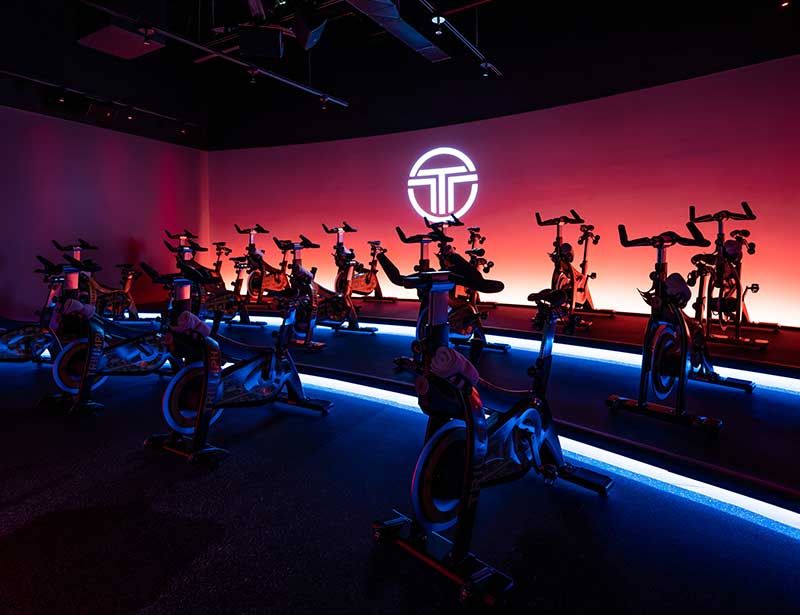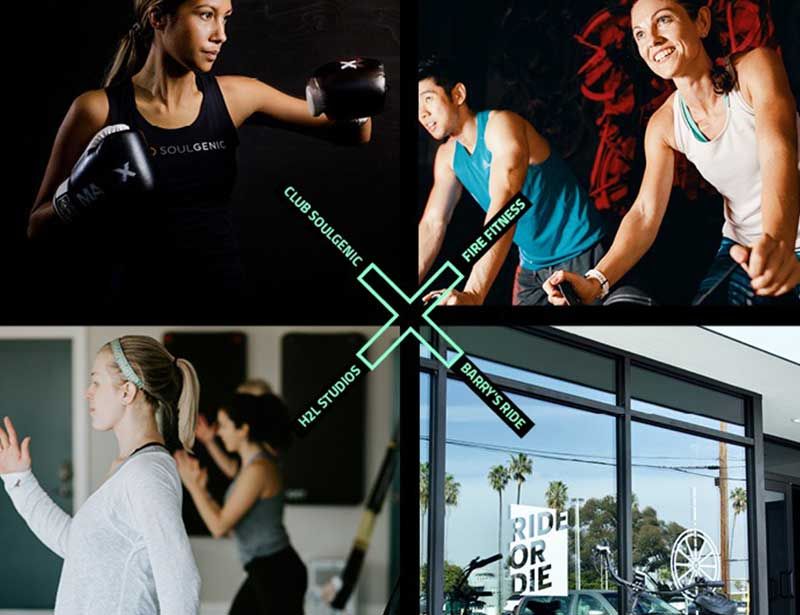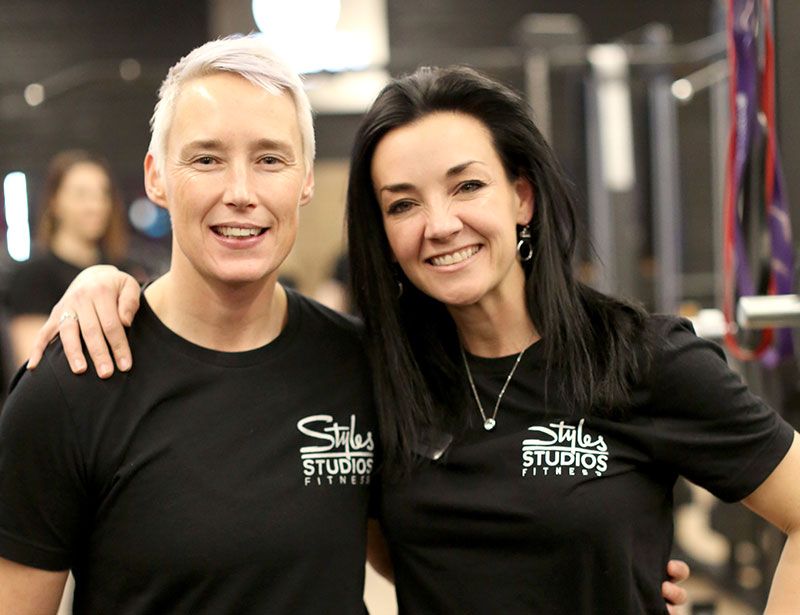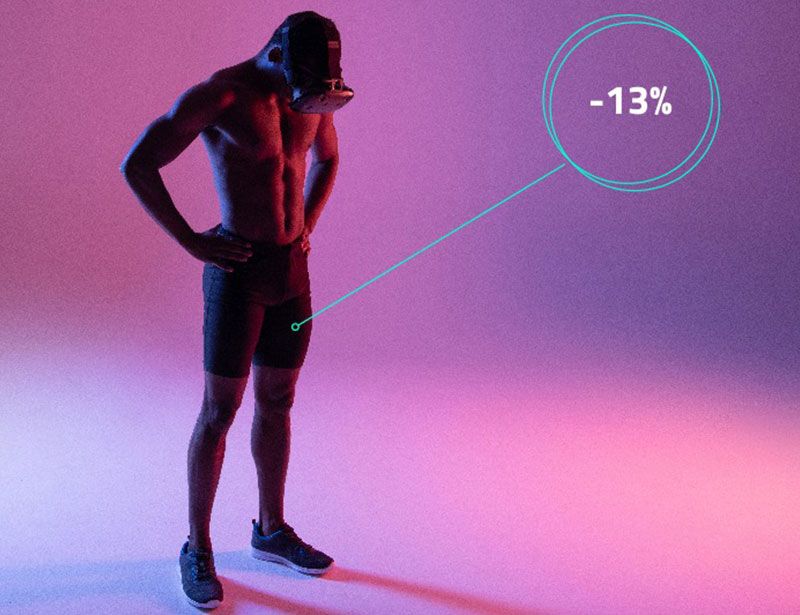From crisis comes opportunity
It is unfortunately not all good news: there have been, and will be more, COVID casualties – the businesses that sadly fell at one of 2020’s many hurdles, breaking apart communities and livelihoods in the process.
Yet for the survivors, the metamorphosis of our sector may just be what it takes to future-proof gyms and studios for years to come.
So often berated for being slow to act, in the face of current challenges our sector has adapted and pressed fast-forward on its innovation, showing itself to be far more nimble, resourceful and resilient than is generally perceived.
Almost overnight, we channelled our expertise into digital platforms, becoming at-home fitness providers. Barry’s is a shining example, the strength of its brand and community allowing it to forge a determined path into the realm of online fitness.
Suppliers have stepped up to the plate too: our BODY BIKE On Demand platform, for example – virtual classes offered in partnership with Wexer – met the demand for ‘any time, anywhere’ exercise and drove bike sales to both home users and corporate gyms.
But at-home will not replace the in-club experience. Already we’re seeing green shoots of recovery for cycling in gyms and studios, as operators find socially distanced ways to deliver workouts – spacing bikes or even running outdoor classes – and members, locked away at home for far too long and seeking human interaction, begin to return to their clubs.
The challenges are far from over. Yet with clubs now re-opened in the majority of countries, we’re hopeful our sector can build towards an even stronger future – one in which people’s
new-found prioritisation of health will reinforce our value to an even broader audience. Finally, I wanted to say a very genuine ‘thank you’. Thank you for all the support you have shown to BODY BIKE – which has retained every member of staff on full pay throughout this crisis – and to this magazine, with subscriber numbers up 10 per cent during lockdown. We hope you find inspiration to move your business forward in the pages that follow.
Uffe A. Olesen
CEO, BODY BIKE International
Joey Gonzalez
Rebranding, RIDE and a transformation inspired by COVID. The CEO of global boutique megabrand Barry’s speaks to Kate Cracknell about 2020’s rollercoaster ride
You recently rebranded to Barry’s, dropping Bootcamp…
Yes. Given the launch of Barry’s RIDE – our new cycling concept – and classes like Release and Lift before that, we realised ‘Bootcamp’ didn’t accurately reflect the different modalities Barry’s now offered.
Barry’s RIDE is the same Barry’s you know and love, just replacing the treadmill with a bike
The new brand – Barry’s – represents, simply and succinctly, everything our clients know and love about the brand.
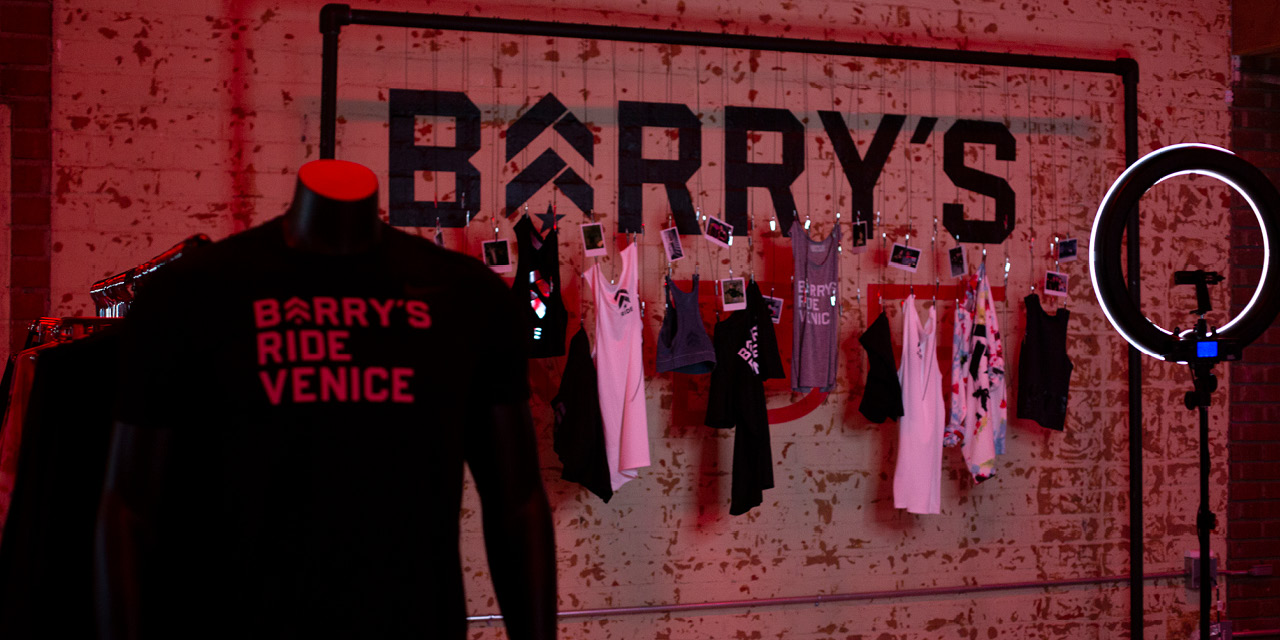
Tell us more about Barry’s RIDE.
We knew we were missing a segment of the fitness population who preferred not to run. We wanted to cater to them, too, and developed the Barry’s RIDE concept as a lower impact cardio option.
Barry’s RIDE is a 50- to 60-minute class that pairs HIIT-style indoor cycling with traditional Barry’s floor work. It’s the same Barry’s you know and love, just with the treadmill of our Bootcamp classes replaced with a bike. Indoor cycling is great for burning calories and shedding body fat, boosting muscular endurance and increasing lean muscle definition – all benefits of the original Barry’s workout, but through a lower-impact modality.
Barry’s RIDE opened in February with studios in New York City – in the lower level of Barry’s existing Chelsea studio (135 W 20th St) – and in Los Angeles, at 1440 Lincoln Blvd, next to the existing Barry’s Venice studio.
Each new RIDE studio has 25 bikes and corresponding floor set-ups. Instructors lead class-goers through bike work and floor work together, rather than in alternating shifts like the original Barry’s workout.
RIDE classes were bookable with any Barry’s class package in NY or LA, with packages also available.
Can you compare RIDE to anything else on the market?
It isn’t like any other cycling class. For one, there’s the Barry’s difference: we are the original cardio and strength training interval workout and our clients know and love us for this. This style of training has been at the core of our business since we first started and it’s mirrored in Barry’s RIDE: no other cycling studio puts as large an emphasis on balancing cardio with strength training as RIDE does.
We know how important it is to find that balance to increase lean body mass, raise metabolic rate (up to 15 per cent) and ultimately, be as fit and healthy as possible.
Our Instagram Lives were so well-attended, it made us confident we could fill paid at-home classes
Any plans to roll out Barry’s RIDE to more sites?
The two initial RIDE sites were extremely successful. They currently remain closed post-COVID, but we’re excited to re-open them and to explore new opportunities in which we can launch.
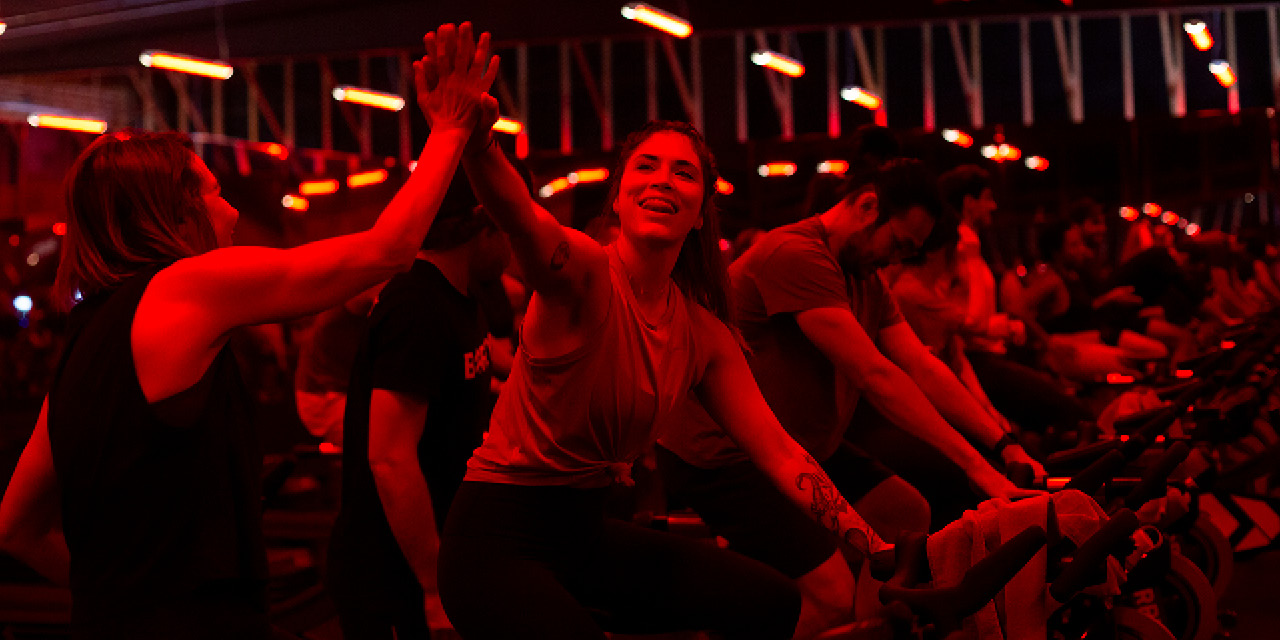
Let’s talk about COVID. How did your business respond to the challenge?
After we proactively shut our Red Rooms, we knew we had to keep people moving. Within days, we started complimentary twice – sometimes three-times daily – Instagram Lives featuring trainers from around the world who led our community in 20-minute workouts. IG Live is a platform that allows viewers to interact with us in real time, and as a brand that places our community at our core, that was important to us.
Our Instagram Lives were so well-attended, it made us confident we could fill paid at-home classes. Barry’s At-Home was born, which allows clients to book and take part in 45-minute classes online or through the Barry’s app.
These classes are held over Zoom and, while not quite the same as being in the Red Room, we’ve done our best to produce a product that truly mimics the connection and high-touch experience that people get from a traditional Barry’s studio. A Barry’s moderator checks clients in, just like the front desk, and instructors correct form and connect with clients in real time, similar to the in-studio experience.
The response from clients has been overwhelming, with sign-ups way exceeding our expectations. We’ve also seen a number of first timers – many living in cities where we don’t have a Red Room – meaning Barry’s At-Home is their first introduction to the brand.
At-Home classes cost US$20 each. As a comparison, an in-studio RIDE class costs US$30
Are you going to continue offering At-Home classes?
Barry’s At-Home will be a permanent addition to our programming. We had actually been working on a digital product for quite some time: the onset of COVID just expedited it. Now, with the world irrevocably changed, we’re entering a new era of fitness. We plan to build out a permanent, robust digital product that’s fully integrated into our app and website.
Already, our At-Home classes are so popular that we offer roughly 100 every single day, taught by instructors from across the US – people who can motivate clients no matter where they are in the world, even through a computer screen.
There are seven types of Barry’s At-Home programme, all of which include blasts of cardio. There’s our bodyweight-only class, because not everyone has gym kit at home; a Band Together class, which uses our resistance, mini and booty band Fit Kit; a weights-only class with dumbbells; Barry’s RIDE, for anyone who has access to their own bike; RUN, our guided runs for the treadmill or outdoors; a weights + band class; and even a traditional Barry’s class with treadmill and weights.
At-Home classes cost US$20 each, or alternatively a membership of US$225 gives you access to up to 30 classes in 30 days. We also have a great range of branded equipment – from bands to benches, free weights to mats – available for purchase at shop.barrys.com.
As a comparison, an in-studio RIDE class costs US$30.
COVID-19 has given us the opportunity to re-imagine our business model
How is your in-studio business performing now?
People are still yearning for connection and are eager for a sense of normality: we’re seeing a demand for classes in the locations that have re-opened.
However, not every studio has re-opened: the majority of US studios are still closed as per CDC and local government guidelines [information correct at the time of writing, 14 August 2020].
We also realise that some clients may still be most comfortable at home. We want to make sure we’re serving them no matter how they feel.
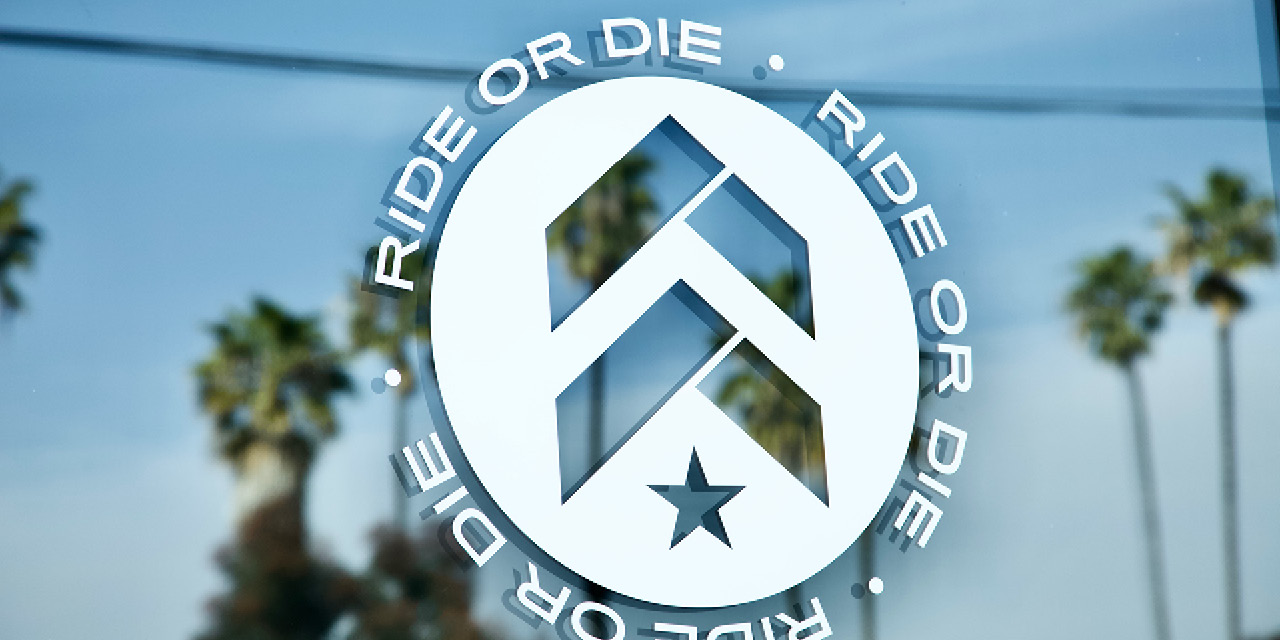
How are you keeping your community safe?
Our main objective and responsibility is to ensure the health and safety of our employees and our community, and to set Barry’s up for a successful re-opening once everything normalises.
Over the past few weeks, we’ve been working diligently on a relaunch strategy and have committed to a three-pronged approach.
- We will be in compliance with all national and local mandates.
- We’ve put together an advisory council of healthcare experts who are helping to guide us on when and how to re-open, based on specifics of the Barry’s workout.
- We’ve conducted focus groups with clients and staff from each city in which we operate, to better understand how our local community on the ground feels and to ensure clients feel comfortable on return.
In addition to reduced class capacity, socially distanced studio layouts and intensive cleaning with hospital grade disinfectant between each class, there will be no sharing of equipment, and of course no high fives or fist bumps. We’ve even installed foot-operated door openers.
In our Bootcamp classes, the class format has also been changed so there’s just one round on the treadmill and one round on the floor, to limit crossover or transitions.
We’ve upgraded our HVAC systems – including hospital-grade MERV-13 filters and bipolar ionization/UV units – and temporarily closed down our showers, lockers, Fuel Bars and water refill stations.
We’re using a geo check-in feature on the app, meaning clients can check-in once they’re within 100 metres of the studio. They are then temperature-checked and asked to confirm they are symptom-free. Sadly, we are also currently asking clients to leave the studio as soon as class is over.
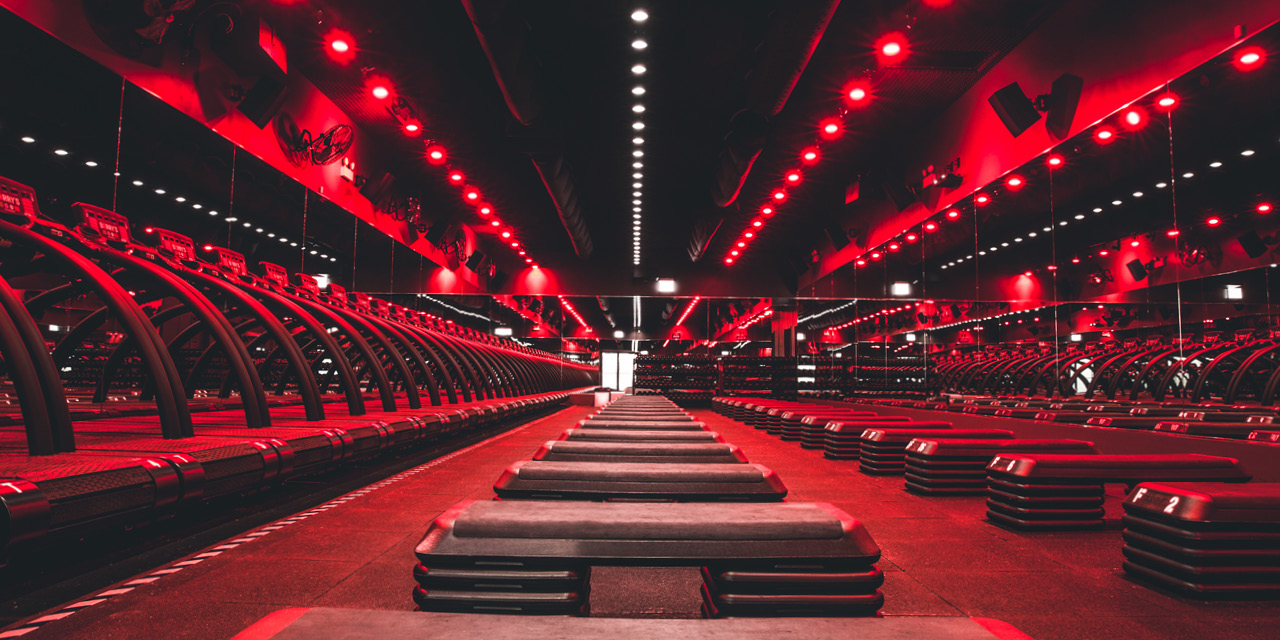
How do you see Barry’s faring in a post-COVID world?
I believe the ultimate effects on the industry will depend on the type of fitness offered. Workouts like Barry’s are very challenging to replicate at home: they require a lot of space for various – and, in some cases, large and expensive – forms of equipment. However, simpler cardio-based workouts may be at risk post-COVID, if customers have adapted to an online experience that they find comparable in quality and value.
Sadly, there may be a meaningful number of studios that don’t survive, and the overall impact on boutique fitness will be challenging.
Once the pandemic is behind us, people will flock back to in-person, yearning for companionship
However, I do believe that once the pandemic is behind us, people will flock back to the in-person experience. Throughout this crisis, people have been cooped up in their homes, in some cases in complete isolation, for a painfully long period of time. I think most will be yearning for companionship and, once the world feels safe again, will replace their tech/virtual routines with ones that re-introduce relationships and human interaction.
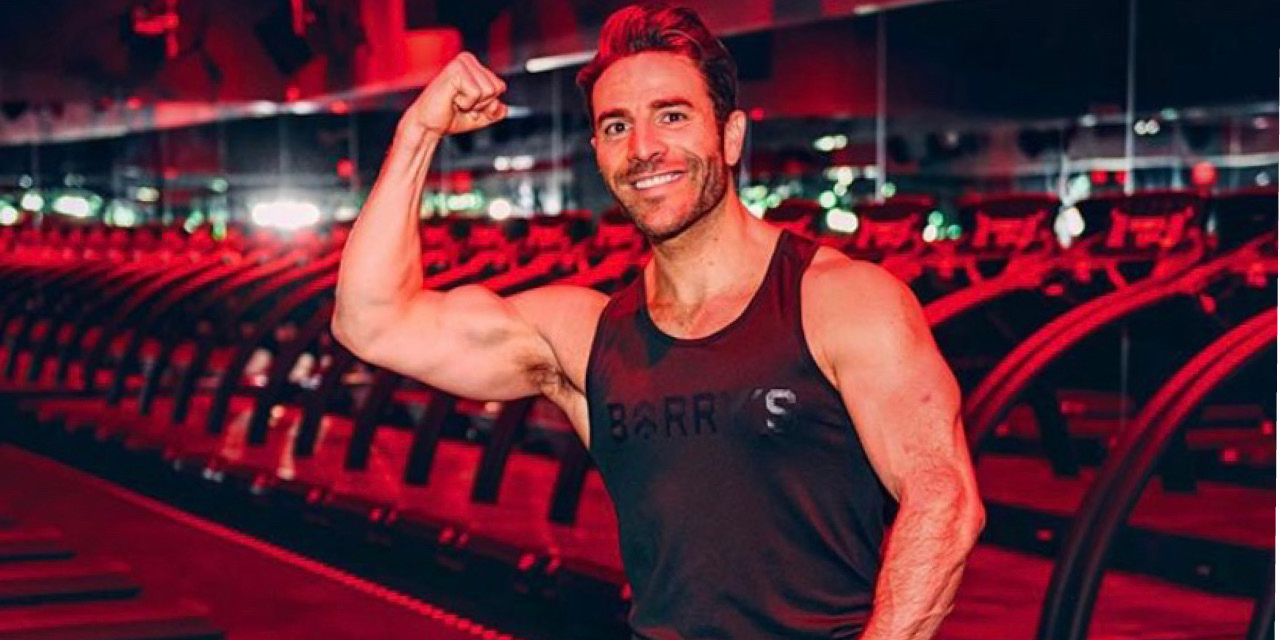
If you look forward five years, where do you see Barry’s?
COVID-19 has been one of the most disruptive experiences we’ve ever experienced, but also one of the most transformative. It has inspired the continued pursuit of creativity and innovation, which has led to us pushing the boundaries of what we can deliver, both in-studio and online. It has given us the opportunity to re-imagine our business model.
In five years, I see Barry’s continuing its global and domestic expansion and continuing to serve our family wherever they are, whether that’s at home or in-person.
Studio design: Know the WHY behind every decision
In today’s world of boutique fitness, whether standalone or club-in-club, indoor cycling studios are sanctuaries of ritual and community. Attendance becomes almost a religion among devoted fans. Symbols (logos) are worn with pride – a mark of identity and belonging. Devotees gather at the appointed time, showing unswerving loyalty to their guru – their chosen instructor.
And just as the world’s religions have their distinct stories to tell, so fitness studios have diversified and created their own philosophies to set themselves apart.
When working with new clients, our first question is always: ‘What do you believe?’
Where previously, indoor cycling looked similar the world over – go-getting, fitness-focused, push hard and then push harder – now distinct models are emerging to appeal to a multi-generational group of devotees. Amid messages of diversity and inclusion, new styles and formats have recast indoor cycling as ‘moving meditation’, spawning a new generation of studios where the focus is less on physical appearance and more on a lasting state of happiness and fulfilment.
It is the belief system, the ethos, the brand story that now distinguishes one cycling studio from another.
Design around the nuances
So, what does all this mean from a design perspective?
Just as architecture differs in form and function across houses of worship, so indoor cycling studios should also be designed based on the brand’s belief.
The studio design for a rhythm cycling class should be very different from the design for a performance class; trying to blend the needs of outdoor cyclists with those of choreography-based rhythm riders, all in one space, is where many studios fail.
IT’S NO ACCIDENT THATFLYWHEEL AND SOULCYCLEHAVE STARK CONTRASTSIN THEIR STUDIO DESIGN
But it isn’t impossible. With keen observation, meticulous planning and great creativity, we’ve been very successful in blending a variety of indoor cycling styles, delivering waitlisted classes and industry-crushing growth for our clients around the world.
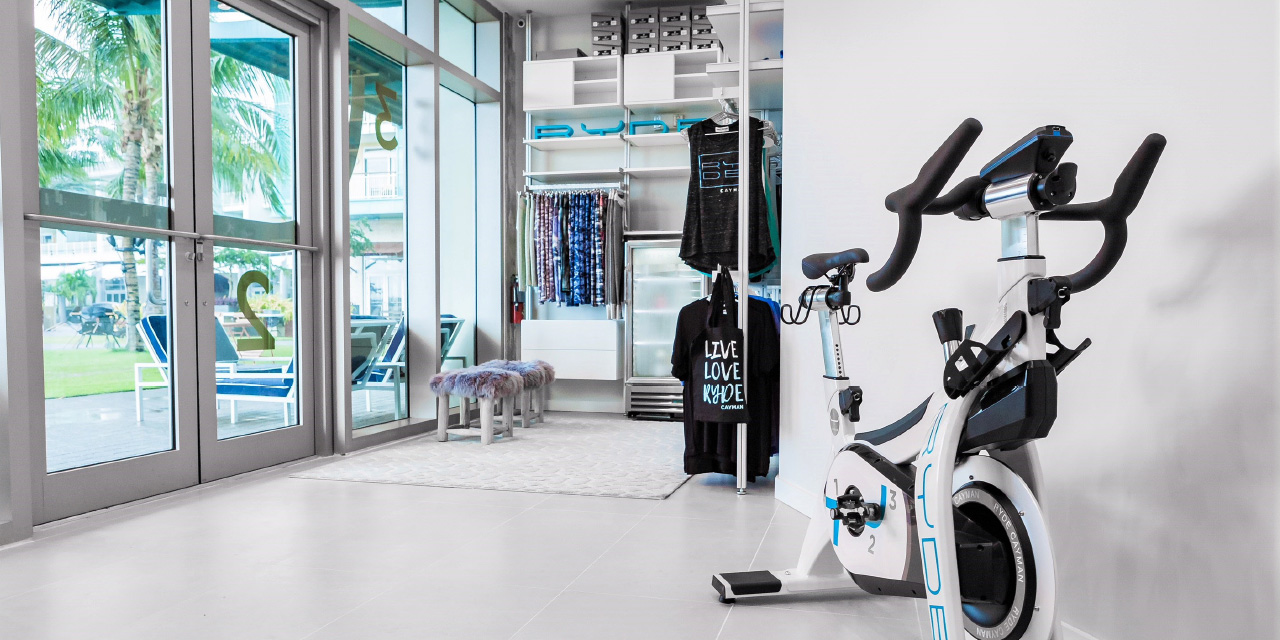
Identify the contradictions
Think about the differences between SoulCycle and Flywheel. Before their division, all three founders had the same beliefs and philosophy. But now? Fly has screens and TorqBoards, Soul has candles and choreography. Soul distributes shoes from behind the front desk, Fly is a self-serve system with shoes in cubbies that correspond to the bike number. Sidebars and bikes on one level or stadium seating? There are reasons behind every decision, and it’s no accident that Flywheel and SoulCycle have stark contrasts in their studio design.
TVs and projection screens can be intrusive in a rhythm class, while the performance crowd enjoys friendly competition and checking stats on a leaderboard. Screens can also be useful for charity events, bride rides, birthday celebrations – yet they are considered “clutter” that contradict the digital detox offered by rhythm studios.
Ceiling or wall fans are mandatory for some studio owners, yet others believe fans cause arguments among instructors and members.
The true roadies and performance cyclists would be mortified to ride with a set of pink hand weights behind the saddle, yet others believe they are essential to the class format.
Even within the rhythm religion, there are contradictions: some teach freestyle with little resistance and an RPM over 120; others adhere to traditional form as certified by the likes of Mad Dogg or Schwinn.
WHY USE THE SAME DESIGN AND LANGUAGE AS YOUR COMPETITOR TO CLAIM HOW UNIQUE YOU ARE?
Chilled, scented towels after the finish line? Some believe in passing them out as a sweet reward – an integral part of a signature class. These studios require a discrete, flush-mounted small refrigerator inside the studio. Others believe towels are a waste of time and money and eliminate them all together. Problems arise when inconsistency creeps in and it’s a hit or miss amenity.
Many studio owners believe clients should come early and stay late. They need studios designed with generous social spaces to create a welcoming community – a home away from home. Others insist on small common areas to allow space for more bikes, which means getting people in and out quickly.
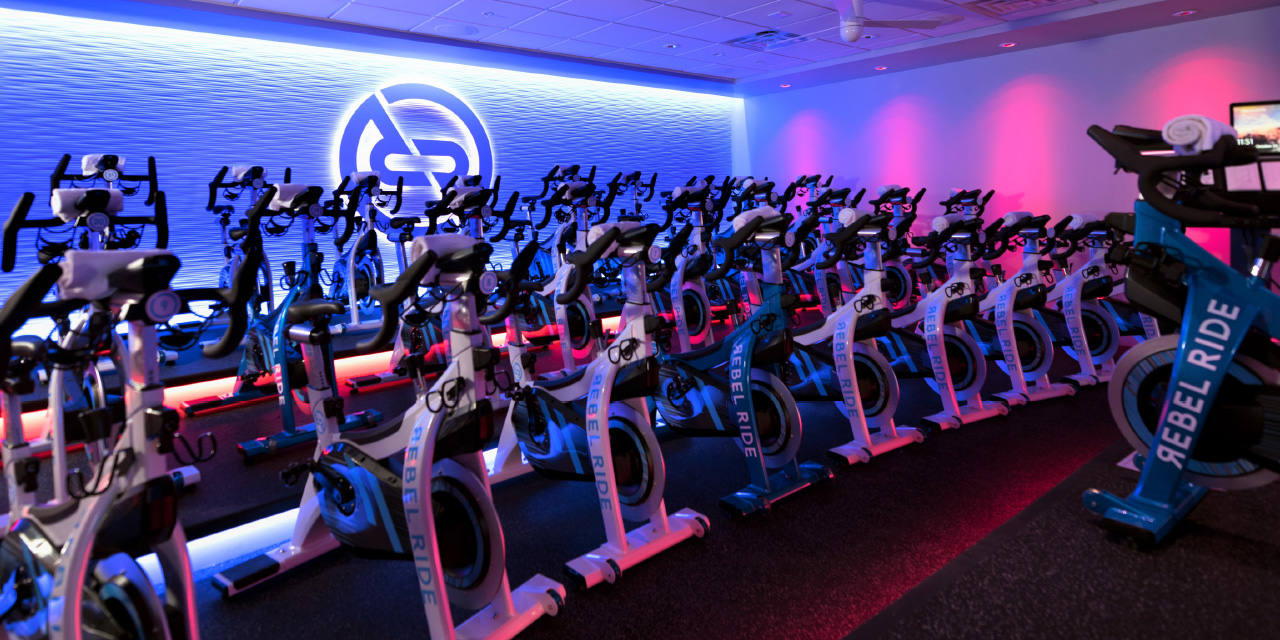
Ask yourself this…
Technical concerns such as sound mitigation, humidity control and reducing slippage will always be a top priority. However, when working with new clients, our first question is always: “What do you believe?”
We then design studios to reflect that belief, asking questions such as:
- Do you believe an instructor should help a client on the third row who comes unclipped or needs assistance during class? If yes, include extra space between rows so the instructor (or assistant) can quickly attend the need.
- Do you believe in occasional team rides with multiple instructors, or do you prefer to showcase only one instructor? The answer will determine the size and weight load of your podium/stage. It will also determine the number of microphones and channels your sound system requires.
- Do you believe instructors should control ceiling fans and dictate when (or if) they come on? If you’re eliminating ceiling fans altogether, know the logic behind this decision. If you’re installing fans, remember to allocate a no-fan zone so clients can reserve a bike away from, or directly under, the fans depending on their preference.
KNOW THE ‘WHY’ BEHIND EVERY DESIGN DECISION AND FIERCELY UPHOLD WHAT YOU BELIEVE
- Do you believe all bodies are the same shape and size? If yes, then place bikes with equal spacing between them. However, I would encourage you to think of an aeroplane, where different classes of seat have different spacing between them. The reasons are different in cycling studios, but there is arguably a similar need for variances in spacing. I’ve noticed that larger people and first-timers tend to take a place on the back row, so space bikes on this row further apart – it will make the lone wolves, and/or those who crave more space, feel more comfortable.
- To meet current social distancing requirements, why not remove the seat post of selected bikes rather than removing the bikes themselves? This keeps mass in the room for better sound; bikes can be rotated to receive equal usage.
- During check-in at the reception desk, do you believe the first thing a client should see is the back of a computer screen or a smiling face?
- Do you believe cycling shoes should be complimentary or rented from you? This determines the best delivery system and location.
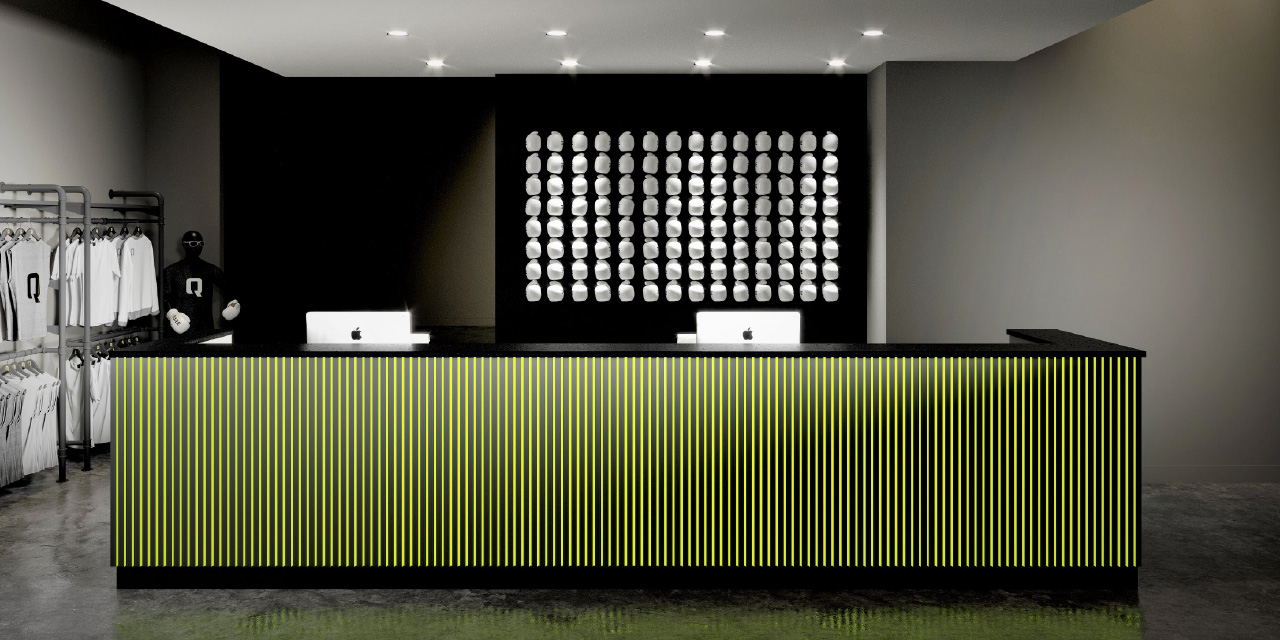
- How often will your studio turn the room for classes? If every 15 minutes, is your ventilation system designed to remove humidity and infuse fresh air, reducing odour and moisture? These are the questions you have to ask yourself in ‘normal’ times. Right now, of course, ventilation is even more critical – and complex – impacting not only riders’ comfort but also virus control. This is an area in which you must not cut corners.
- Do you believe clients should struggle to walk in cycling shoes? Slippage continues to be a cause of falls and potential lawsuits; sweat mixed with body lotion is a recipe for disaster on polished concrete floors.
- Does your brand have a signature scent? From grapefruit to lemon verbena, infuse a subtle yet memorable aroma into your studio space through a timed release in the ventilation system, for effective scent marketing.
There are no right or wrong answers to the above questions, but it is important to think about these details. You’d be surprised by how many people don’t. If you want your brand to inspire loyalty and ignite imagination, why would you use the same design style and brand language as your competitor to claim how unique you are?
Before hiring an architect or selecting a location, you must know the ‘why’ behind every design decision and fiercely uphold what you believe.
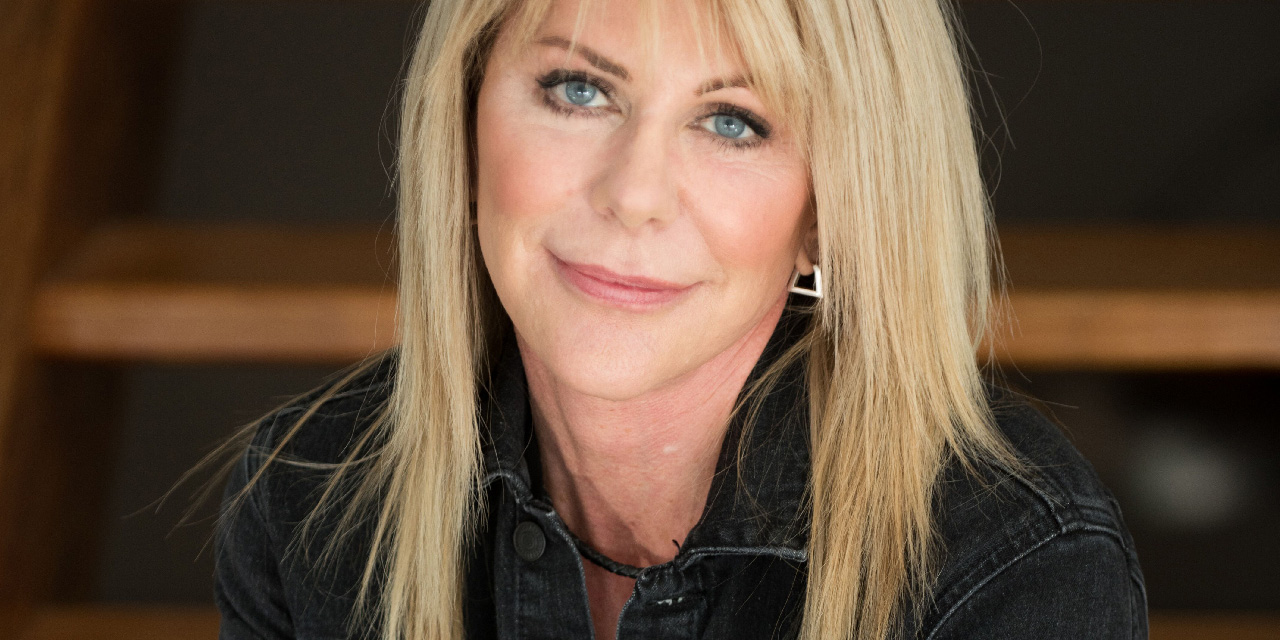
About the Barbara Chancey Design Group
“Unlike many traditional design firms, my entire team teaches, takes or observes classes relentlessly,” says Barbara Chancey, founder of the Barbara Chancey Design Group. “Our strength comes in designing beautifully functional spaces, approaching every brief through the eyes of instructors.
“Always mindful of the enormous effort it takes to fill a class, we include thoughtful features for instructors, with meticulous details to help them deliver a superior experience. This results in creative classes, increased retention, waitlists and industry-crushing growth for our clients.”
She continues: “When working with new clients, our first question is always: ‘What do you believe?’ We then create studio designs to reflect that belief – designs that reflect your brand and that are able to grow with you.
“In the words of Simon Sinek from his TED Talk on great leaders: ‘Hire people who believe what you believe, and you’ll never fail.’
“Studio owners, what do you believe?”
Mix & Match
When Barry’s, famous for its bootcamp classes, launched two Barry’s Ride cycling studio pop-ups earlier this year, it sent ripples across the sector.
With Peloton and other home bikes commanding more and more interest, some had felt the future of the indoor cycling sector might find itself squarely in the at-home space. But the arrival of Barry’s into the studio cycling market? That flew in the face of such assumptions and caused a frisson of excitement.
“I tried Barry’s Ride and it’s like if your favourite cycling class and HIIT class got married,” enthused one NYC-based fitness editor.
Cycling isn’t dead. Innovate and it could bring a new appeal to studio classes
Barry’s had successfully brought its tried and tested formula – cardio + ‘body part of the day’ resistance – to the world of cycling, with 25-30 minutes on the bike followed by 25-30 minutes’ floor workout, all wrapped up in the brand’s inimitable style.
“Cycling certainly isn’t dead. It’s increasingly happening at home rather than in-studio, but innovate and it could bring a new appeal to studio classes,” observed Jon Canarick, MD of North Castle Partners – investor in both Barry’s and Peloton rival Echelon – at the time of the launch.
It’s an understatement to say that much has happened in the months since those NYC and LA pop-ups. However, what’s also true is that the appeal of studio classes remains, even in this post-COVID era.
Studio capacity may be limited for the time being. Nervous exercisers may be sticking with at-home exercise for now. But demand for the live GX experience is very much there; speaking to numerous operators around the world, it is group classes specifically that are causing the headaches when it comes to demand vs currently-possible supply.
All of which is good news for the indoor cycling sector, and a reason to keep innovating. We take a look at just a few of the many other great examples of fusion classes on offer around the world.
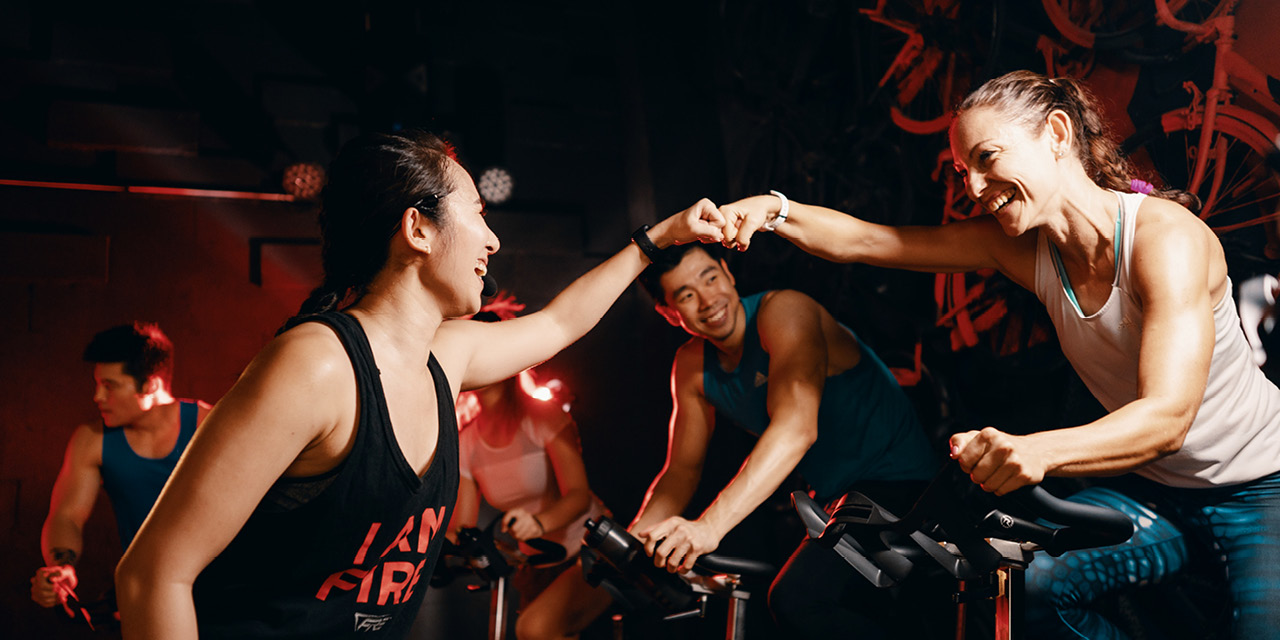
FIRE Fitness – Malaysia
“To create a powerful boutique experience, you have to offer something unique, something clients won’t be able to find anywhere else. With this in mind, 80 per cent of our signature classes are fusion: STRIDE (treadmill running + weight training and bodyweight movement); STRIKE (boxing + weight training and bodyweight movement); RIDE YOGA; RIDE HIIT; and FIRE BARRE (ballet-inspired class with HIIT exercises). Then there’s FORCE, which focuses purely on strength and conditioning.
“Our RIDE YOGA classes – of which we offer four a week, alongside 12 RIDE HIIT classes – combine the thrill of HIIT cycling with the calm of yoga and all the associated benefits of flexibility, such as injury prevention.
RIDE YOGA goes beyond the physical: it’s the yang and yin of the indoor cycling genre
“A standard 45-minute cycle class will focus on building cardio fitness and calorie burn. A 30-minute RIDE class with a focus on HIIT, followed up with some power yoga, can achieve the same calorie-burning benefits. But RIDE YOGA goes beyond the physical: the mental benefits of pushing yourself on the bike, followed by the calm focus of yoga, is a perfect combination both physically and mentally. I like to call it the yang and yin of the indoor cycling genre.
“RIDE YOGA has been very successful in bringing new audiences to yoga: athletes who previously focused solely on their fitness and strength, never considering that they might enjoy yoga, which is such an amazing way to channel focus and calm and build flexibility. Our trainers are well-versed in catering for all experience levels, and it’s been exciting to see people who joined a RIDE YOGA class with zero yoga experience going on to join full yoga classes.
“Our classes are unapologetically geared towards results, which is ultimately what our clients want. They aren’t easy, but our trainers are highly motivating and it’s a very contagious environment to be in.
“All our RIDE YOGA classes are at 100 per cent capacity, with waitlists. Yes, right now we are managing a PC (post-COVID) capacity of 75 per cent, but even prior to COVID the classes were at 100 per cent. It a very time-efficient, results-focused workout – in 45 minutes you train cardio, strength, core and flexibility – plus every workout is different, which keeps it interesting for clients.
“We would love to add more RIDE YOGA classes to the timetable; the challenge is finding cycling instructors who are also qualified yoga teachers.”
Tracy Minnoch-Nuku
Creative Director, FIRE Fitness
www.firefitness.com.my
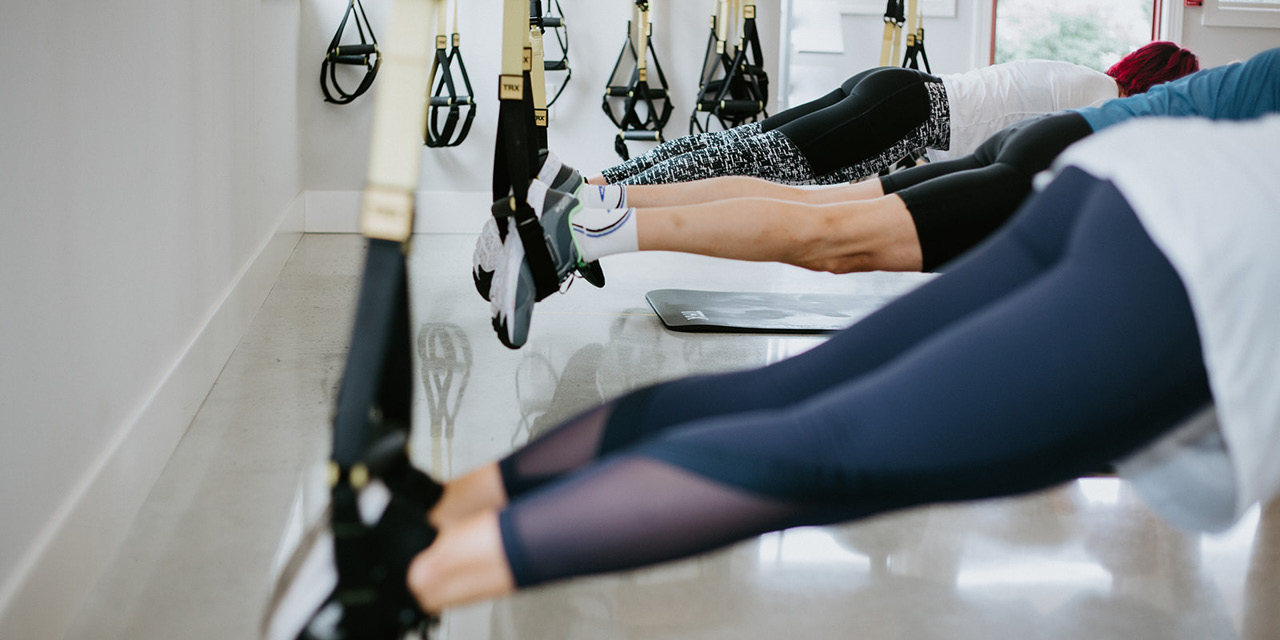
H2L Studio – Pennsylvania, US
“Before COVID, almost half of the cycle classes on our multi-discipline timetable were combo classes: Cycle+Core, Cycle+TRX, Cycle+Bootcamp, Cycle+Yoga HIIT and Cycle+Power TRX. We even added a few ‘triple threat’ classes: Cycle+Bootcamp+Core, for example, with the last few minutes dedicated to core work.
“We scaled these classes back a bit when we re-opened, but everyone’s asking for them back, so I imagine we’ll get back to a similar level in the not too distant future.
“We start all combos with a 30-minute cycle class. It’s a great way to get everyone warmed up before moving to the next room for the second portion: 15 minutes for core; 20 minutes for TRX and Bootcamp; 30 minutes for Yoga HIT, to include some relaxation at the end.
“And then all the combos end with a good stretch. Our goal is for people to leave feeling they got a good, intense workout, but also relaxed and refreshed rather than exhausted.
“We love normal cycle classes, don’t get us wrong, but the combo classes really are a ‘bang for your buck’ kind of set up. You get some good cardiovascular work and some intense but intentional muscle toning work, and you’re still out of the door in 60 minutes or less.
When you sandwich things together in shorter, less intimidating sections, it encourages people to try new things
“These classes are very popular among those who can’t make it to the studio as often, because they get two workouts in one. And generally, people love them because they feel they’re really getting their money’s worth.
“That’s important, because today’s clients are looking for instant gratification: they want to feel what they worked on when they walk out to their cars. They want that intense burn. Combo classes are great for this.
“It’s also the case that some people simply don’t enjoy 45 or 60 minutes of the same type of activity. In our combos, right as they are thinking: ‘OK, how much longer do we have to cycle?’ you have them off the bikes and onto the mats. Clients always say they like these classes because they never get bored. By combining two modalities, you keep their interest for longer.
“We get the people who don’t normally cycle too, as well as the people who usually only cycle. When you sandwich things together in shorter, less intimidating sections, it allows you to show what else you are made of and encourages people to try new things. And of course, everything can be modified for newcomers and made more challenging for veteran clients.
“The only downfall of these combo classes, at least in our set-up, is that you’re taking up two spaces during some of the more popular slots. However, our clients don’t seem to mind: they plan their week around the timetable.
“If you have a lot of local competitors, adding combo classes can be a fun way to make your studio stand out. You become a one-stop shop.”
Courtney Farinelli
Studio manager, H2L Studio
www.h2lstudio.com
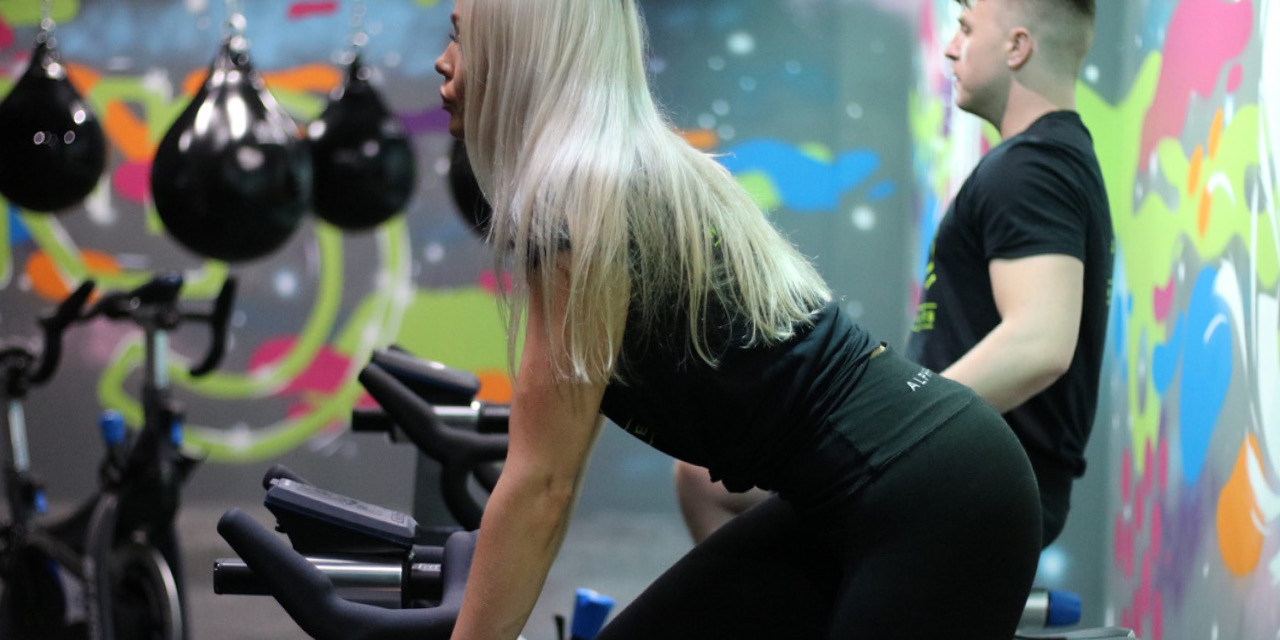 Club Soulgenic – Jersey, British Isles
Club Soulgenic – Jersey, British Isles
“We’ve deliberately given our fusion class its own trademarked brand: Gearsngloves.
“The class is a combination of boxing and indoor cycling, with two instructors in the class: our ‘double trouble’ concept! One instructor leads the boxing, the other the cycling.
“Although boxing and cycling are obviously quite distinct genres, we retain the same atmosphere throughout the class thanks to the interaction of the class instructors and the music.
“The 50-minute class consists of a five-minute warm-up as one group. Participants then split into two groups, with one group boxing and one group cycling for 20 minutes. They then switch and do the other discipline for 20 minutes, before coming back together as one group for a final five minutes of core and stretching.
“It’s a seriously high-energy class, with a funky playlist and big results – all using MYZONE to track performance – and it’s absolutely exploded. It’s our most popular class by a country mile.
Gearsngloves runs at nothing less than 90 per cent capacity, even though it’s twice the price of our other classes
“The physical benefits are huge: boxing for the upper body and cycling for the lower body, with a great combination of cardio and strength/power. It’s targeted at the fitter population of our club and people who want a challenge, and our members have told us it’s the perfect workout. Plus it’s fun: the variety and the fun factor is 100 per cent a winning formula.
“We offer seven Gearsngloves classes each week, one a day, as part of a wider timetable of around 60 classes including ‘normal’ cycling classes. Gearsngloves runs at nothing less than 90 per cent capacity, and when the classes run at peak times, they have a longer than average waiting list. This in spite of the fact that Gearsngloves is twice the price of all our other classes.
“We now want to take Gearsngloves out of Jersey into a major city in the UK. We think, as a standalone boutique concept, it has serious potential. We also think community will be prized more than ever after all of our experiences of lockdown.
“We know where we want to find a site, but I don’t want to say too much yet. We are open to an investor coming in with us for this and may eventually offer it as a franchise option.”
Dr Glenda Rivoallan
Founder, Club Soulgenic
www.clubsoulgenic.co.uk
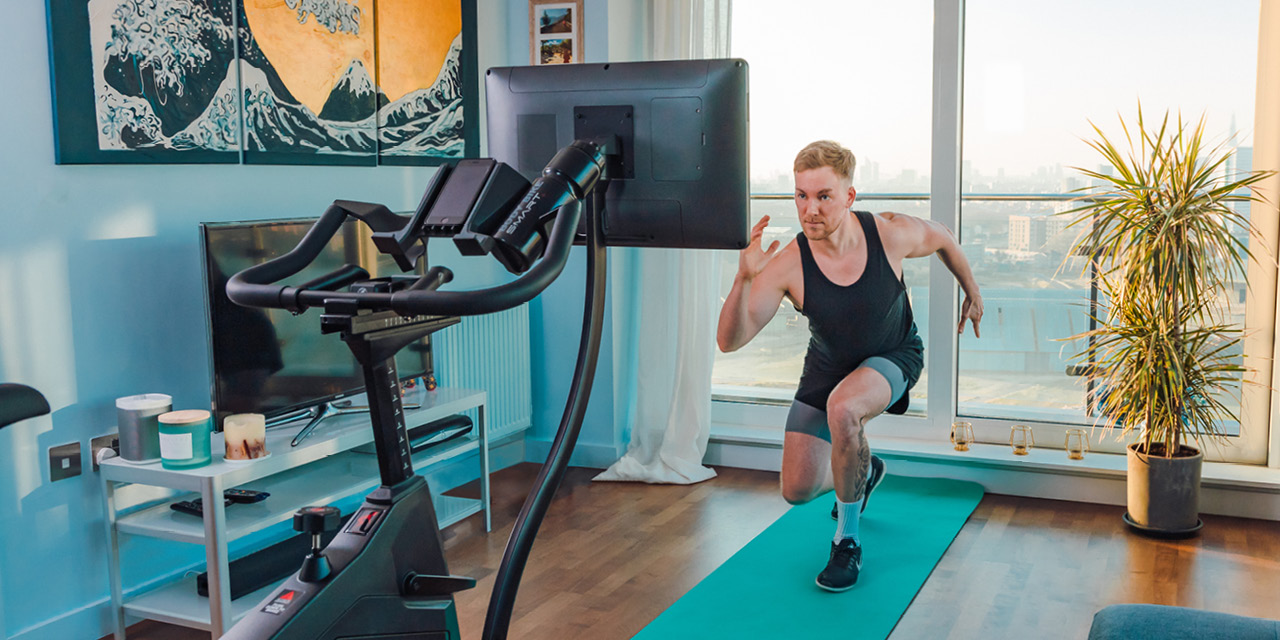
Fusion @ home
What COVID-19 has taught us all is how to exercise from home.
In the process, we’ve developed a taste for digital fitness. We’ve had our eyes opened to the quality and quantity of exercise content in this online world. We’ve experienced brands’ top instructors. We’ve found ourselves pleasantly surprised by the experience.
Fitness was always moving in this direction – even pre-COVID, on-demand fitness was experiencing huge growth – but the crisis has unquestionably accelerated things. Most operators now acknowledge that a digital facet to the member experience is a must: not a replacement for the live experience, but a positive complement for the days when life/work get in the way of your gym visit.
Imagine today is one of those days. You were hoping to do a cycling fusion class at your club, but now you can’t make it. How do you replicate that at home – or indeed in any other non-instructor-led environment, from office spaces to hotel fitness suites to unmanned gym floors?
SWITCH is the perfect tool for digital ‘fitness snacking’, enabling DIY fusion classes
Where do you go for an expert-led workout that fuses cycling with a second, complementary floor-based class – and potentially even a third, combining cycling with, say, strength and stretching – all within the 45 minutes you’ve allocated to your workout?
Step forward Body Bike SMART+ SWITCH. With its 21-inch, 180°-rotating touchscreen, this new indoor cycle allows users to flip easily between cycling workouts on the bike and floor-based workouts in front of it – all led by top instructors from around the world.
Created in collaboration with digital fitness expert Wexer, SWITCH’s screen comes pre-loaded with over 600 music licence-free, on-demand classes. There are 100+ cycling classes, but also hundreds of other workout possibilities spanning everything from yoga to stretching, strength to HIIT, meditation to dance.
Around 60 per cent of the virtual cycling classes are 30 minutes or under; over 20 per cent of these classes come in at 20 minutes or less. Floor-based classes follow suit – and in fact, there’s a great selection of even shorter classes too (10 minutes and under), from stretching, foam rolling and meditation to short format strength and conditioning.
With shorter format classes already emerging as popular options among users, SWITCH is the perfect tool for digital ‘fitness snacking’, enabling DIY fusion classes that still deliver a polished, professional experience.
Heart & soul
What’s your background?
My background is in musical theatre. I went to the BRIT School for years 10–13, which is when I started to perform. I focused on dance, which I’ve always loved, with a bit of singing on the side. That was followed by a three-year musical theatre degree at the Urdang Academy in Angel, north London.
And then, five years ago when I graduated, I was suddenly out into the big wide world of performing. In fact, my first gig was a TV ad for KFC, but as a dancer/singer I was always aiming for the big West End shows. I kept getting close but would never quite land the role – not until I changed agent. My first audition after that, for Hairspray, I got the job. We toured the UK for 10 months starting April 2017.
I learned a lot about myself on that tour: I felt I found my voice. And I absolutely loved the whole experience. I knew it was what I wanted to be doing.
So, how did indoor cycling come into the mix?
One of the things I loved about Hairspray was the buzz of being on-stage. The adrenalin, the sweatiness, the excitement of being part of a big cast. When the tour finished and I didn’t have another show to go into, I started looking for something else that would give me that same feeling.
Some days I’ll feel like I’m Oprah. Other days I have to let the music speak for me!
I decided to train as a fitness instructor, and then I did a group cycling qualification too. I’ve always loved cycling classes: they can be tough, but if you find an instructor who’s on your wavelength, who chooses music that resonates with you, if you’re in a room full of people whose energy you can feed off… I love it. Especially the music. It’s 100 per cent about the music for me.
Once I’d done that qualification, I sent my CV to Core Collective and ended up joining its team in South Kensington, as a cycling instructor. I worked with some great people there, learning from them, finding my vibe, building up my community.
How did you juggle this alongside your musical theatre commitments?
At the end of July 2018, I started a three-month run in Eugenius! The Musical. It was off the West End, but right around the corner from Wicked in the Victoria area of London. It felt like I was getting closer to my dream.
Eugenius was eight shows a week, and I was also doing five classes a week at Core Collective. I’d get home from the show at 11.00pm and then, Saturday morning, I’d have classes at 9.00am and 10.00am. But I love to be busy, so that was fine!
In a way, being a cycling instructor… it’s like having my own show
I carried on doing classes at Core Collective throughout the three months of the show and beyond, but I was also doing auditions for the West End, and this time I was getting so close. I got into the final casting round for Book of Mormon, 9–5 The Musical, Tina the Musical… I had four potential roles and my agent was so convinced I would get one of them – but then it didn’t happen. I didn’t get any of them.
It was devastating. Heartbreaking. My confidence was knocked and I started to question my goals in life. If I’m honest, I’m still trying to decide if I want to keep trying for the West End – I’ve certainly taken a break from auditioning for now.
It’s hard to stop when it’s something I’ve trained so hard for, when it’s always been my dream. But equally, I’m learning to accept that it’s OK if my dream has changed. And in a way, being a cycling instructor – it’s like having my own show. I’m on a podium, in the spotlight, and it’s up to me to capture and hold the attention of the 65 people in the room. I have to perform.
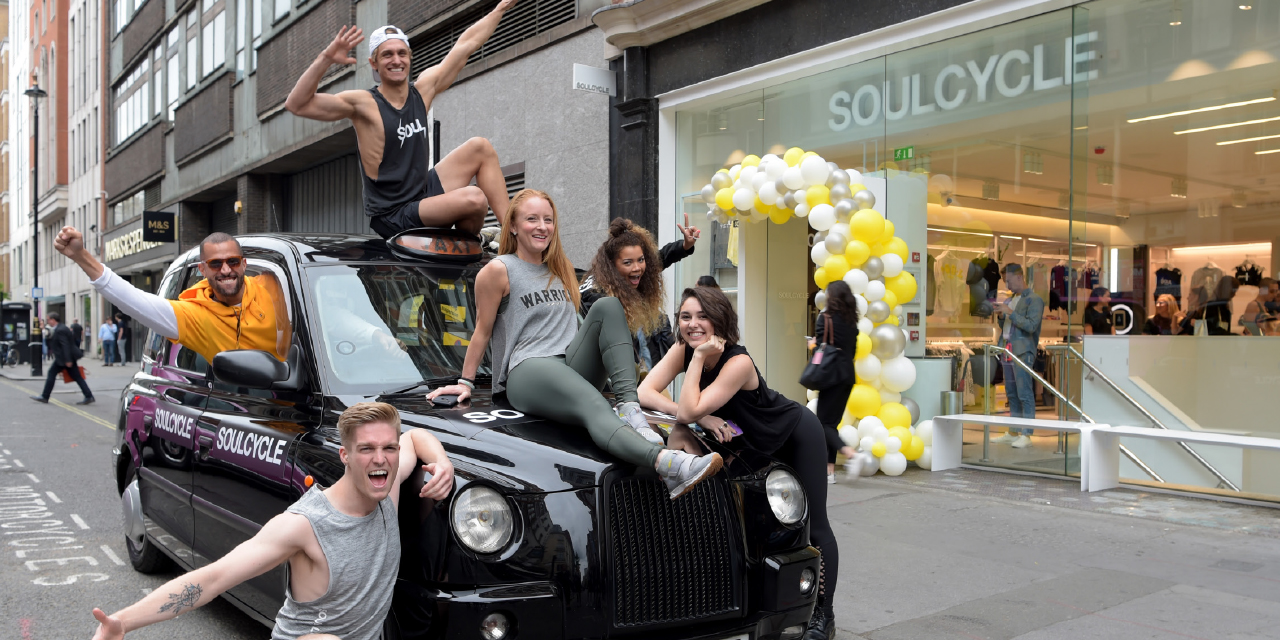 You’re now an instructor for SoulCycle London. When did that happen?
You’re now an instructor for SoulCycle London. When did that happen?
It was when SoulCycle was getting ready to launch its first UK studio in the Soho area of London. There was an audition of course, but honestly, after my experiences in the West End – all those blunt rejections – everything about SoulCycle felt so positive. The compassion I was shown even during the audition… it just felt totally different. And it felt right.
I ended up being offered one of the three UK instructor roles and I absolutely love it.
What sort of coaching did SoulCycle give you?
I was part of the first UK team to train as SoulCycle instructors, ready for the Soho launch last summer. As the first team, we would become the faces of SoulCycle in the UK, representing the brand and helping to build its name in a new market.
We were flown out to New York for training, which was a fascinating process. SoulCycle talks about it as peeling back the layers. They challenge you to keep digging, to keep peeling back the layers, to explore who you are. And then you’re put back together again, still true to yourself but everso slightly different, able to hold yourself a bit prouder.
As part of that process, I learned how to open up to the class, talking about my life: friendships, relationships, something interesting I might have heard in a podcast… SoulCycle is absolutely about soul. You’re there to be yourself, to bare your soul. It’s the SoulCycle way to be more personal in class than at other places.
During class, I’ll talk about my mum, my cat, what happened to me on the bus that morning. You’re encouraged to be yourself – and people do respond to personal stories. You start chatting and their heads go up.
I found it difficult at first – I had never talked about my feelings as openly as perhaps instructors in the US had – and even now, I don’t always find it easy. Some days I’ll feel like I’m Oprah. Other days I have to let the music speak for me!
What would you say is your style of instructing?
I’m both strong and soft. I want people to work hard, but equally I make it clear you don’t always have to be perfect, and that ‘working hard’ looks different for everyone. Whatever you’re able to give to the class on any given day, that’s enough. Don’t compare yourself to the person next to you. Just know how you feel in your own body.
I read the room, making it challenging for all levels but also accessible to everyone who’s in there with me. In the end, I just want people to walk out at the end of class feeling proud of themselves, feeling stronger as a person. Our mission is to move people to move the world.
I also make sure I put myself out there, absolutely every class. People think what we do is easy, but it isn’t. It’s blood, sweat and tears. You have to make others feel good even if you’re having a bad day. If you show up for your community, giving your all every time, they will show up for you.
I’ve evolved so much as an instructor during my time at SoulCycle. I’ve become far more confident, both in my instructing skills and in my own skin. I’ve learned to take the space, to be true to myself, to put myself out there every time and not apologise for what I do. And that’s what I encourage in my community too. I want more for myself and I want more for them.
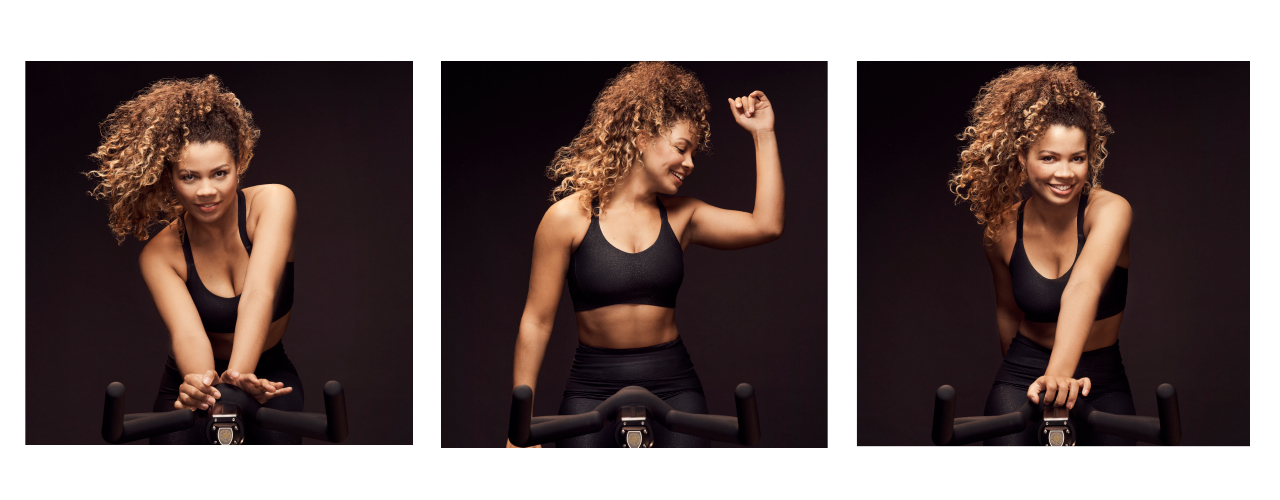
What does your role at SoulCycle involve?
Before lockdown, I was doing 11 classes a week: six at Soho and five at Notting Hill, SoulCycle’s second London studio which launched in November last year.
I’m now back instructing at both of those locations and am keen to continue working across different SoulCycle studios as the portfolio grows: I’m hoping to get up to 12 or 13 classes a week when our next London studio opens.
There’s a lot of prep work: we’re not just instructors, we’re curators of the experience
In between the classes, there’s a lot of prep work. We’re not just instructors, we’re ‘curators of the experience’, and the experience we curate is unique to each of us, driven by the energy we give out, the moves we do, the music we choose.
Music is one of the most important aspects of a SoulCycle class: we create different playlists for different classes, which also means different choreography for each class. As you can imagine, then, we all spend a lot of time looking for new tracks and remixes: you can be deep-diving for six hours and only find three tracks! But you might find a track you think would suit the teaching style of someone else in the SoulCycle community; we all send songs to each other.
Finally, we also represent the SoulCycle brand on social media. That means being accepting, friendly, real, authentic.
How does Notting Hill compare to Soho?
Again, I’m looking back to pre-COVID here, but Notting Hill was always very different from Soho and a great learning curve.
Soho always had the passing trade, with lots of offices nearby and tourists walking past the studio and trying a class. Notting Hill is very residential, so I had to build a community from the ground up.
Some classes I had to work really hard to do that. I did things like themed rides, for example, and I worked hard to understand the nuances of the market to get my music choices right. One class, on a Thursday lunchtime, I started doing Soul + Abs: 15 minutes of ab work at the end of the class, for free. Lululemon gave me some mats for the foyer area – as of February this year, I’m also a Lululemon ambassador – and we made the space look really professional.
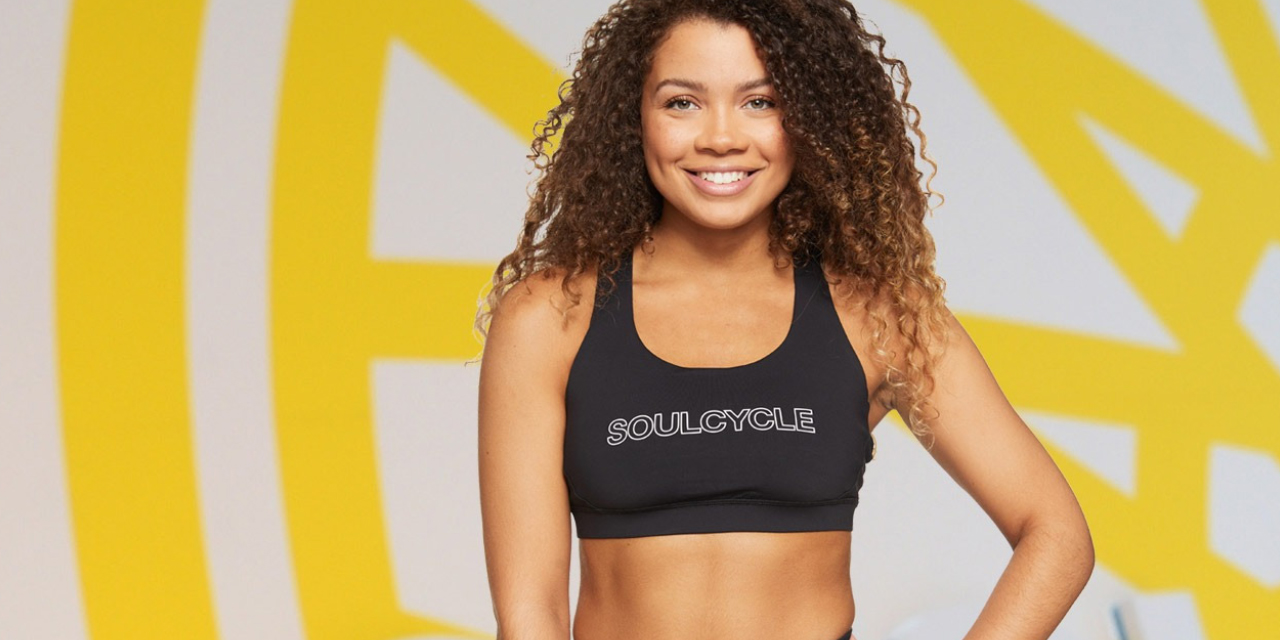
As an influencer, do you run any online fitness programmes?
I started doing an Arms & Abs series when COVID-19 put us all into lockdown, going live on Instagram at 1.00pm every day. But at that point, everyone was doing the same. In the loveliest way possible, social media became a bit over-saturated with fitness content, and as a freelancer – hoping for a few donations where possible – it was hard to compete, especially when some of the big studios were putting content out there for free.
I’ve had people complain or leave early. That’s OK. You can’t be everyone’s cup of tea
Plus, I actually find it quite hard to create good fitness content through Instagram. For me, it’s all about feeding off the vibe of the room and the people in my class. I’ll see someone in the back row trying to keep up, or I’ll see someone upfront really pushing hard, and I’ll respond to that. On Instagram, it’s just you and a camera. You get nothing back other than the occasional emoji. As a result, I find I struggle to deliver in quite the same way.
What would you say is the secret of your success?
Being myself. Being open to new opportunities. Not being stubborn – not sticking to plan A if a great plan B comes along. After all, all of this has happened in just five years since I left the Academy. I think that’s because I always try and look at things with a “what have I got to lose?” attitude.
What advice would you give to other cycling instructors?
You can’t please everyone. I’ve had people complain, leave class early, not like my music choices. That’s OK – you can’t be everyone’s cup of tea.
In the end, you have to like what you’re doing, because you’re the one who has to do it. And you will find your tribe of people – the people who keep coming back because they like what you’re doing, who connect with you because you’re being your authentic self. So that’s my advice: just be yourself.
Styles Studios Fitness
What was the opportunity you identified for Styles Studios Fitness?
We saw an opportunity to cut a lane between the boutiques and the big boxes.
Styles Studios Fitness is located in Peoria Illinois, in the United States’ Midwest, and boutique studios are incredibly expensive for small and mid-sized cities like this. People might try them for a while, for the novelty factor, but they just aren’t willing to pay US$20 per class on an ongoing basis.
We wanted to bring a niche, boutique experience to people at a more affordable price.
How would you describe the Styles concept?
We’re still looking for the perfect way to describe our 14,200sq ft club, but so far the descriptors we use are “a health club of boutiques” and “Four and a Floor” – the latter because we have four distinct boutique studios and a gym floor, all under one roof.
Every studio has its own entrance and its own signage. They really are four unique boutiques side-by-side, and between them they offer over 350 live and virtual classes every week; that’s still the case post-lockdown, albeit the proportion of virtual classes is currently slightly higher than it was.
Classes run all day, every day and you can book them through our app. In fact, since re-opening, you have to book so we can manage capacity; we have a strong set of procedures and a #StylesSafe campaign, which is all about operating safely and building member confidence in the aftermath of COVID lockdown.
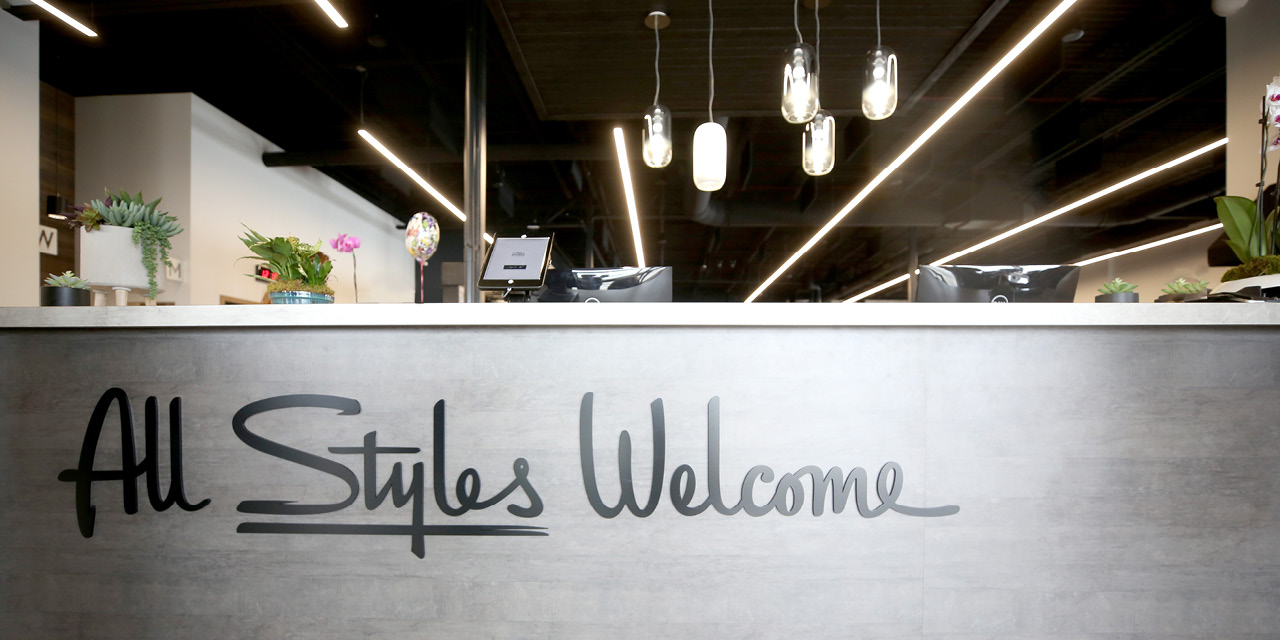
Tell us about your boutiques…
CHAIN is a 1,350sq ft, 35-bike immersive cycle studio – currently running at around 50 per cent capacity – where a 12 x 42ft curved wall screen provides participants with a cinematic experience.
FREESOL is a 1,000sq ft hot yoga studio with pre-COVID capacity for 25 participants; it’s also sitting at about 50 per cent capacity at the moment. It’s designed to create a sense of escape, with the only lights in the studio dimmable to the point that the walls just gently glow.
HUSTLE is our small group training studio – a 1,500sq ft space that holds just 16 people for very personalised coaching. The studio has a real wow factor, with eight massive strength training rigs and eight Woodway treadmills. It’s strength and conditioning made cool, all set to music and with regular CV hits on the treadmill to boost endorphin levels. These classes are still able to operate at their normal 16-person capacity and are 100 per cent booked all the time; we’ll be adding more in the Fall. In the meantime, as we have a huge outdoor space, we’ve also launched HUSTLE Outside and get 60–80 people per class at the weekend – all in line with state guidelines.
URBAN RITUAL is where we host our traditional group exercise classes, but these are taken to the next level thanks to the environment. There’s an incredible light show, a huge video wall at the front – big enough that, in virtual classes, instructors are life-sized – and the whole place feels like a nightclub. The theme that pulls it all together: “The music made me do it.” At 1,000sq ft, this studio usually holds 25 people; it’s currently around half that.
Meanwhile, the FLOOR is around 5,500–6,000sq ft and is equipped by Precor. There are 24 pieces of cardio equipment; pin-loaded strength and free weights; and a functional area, with a Queenax rig, taking up around a third of the gym floor. We’d make the functional space even bigger next time.
We also have a smoothie and coffee bar, nutrition and wellbeing coaching, and the region’s first Dexa Wellness office offering medical-grade body composition scanning and other fitness testing.
Virtual is like going to the fitness movies: our immersive environments drive engagement
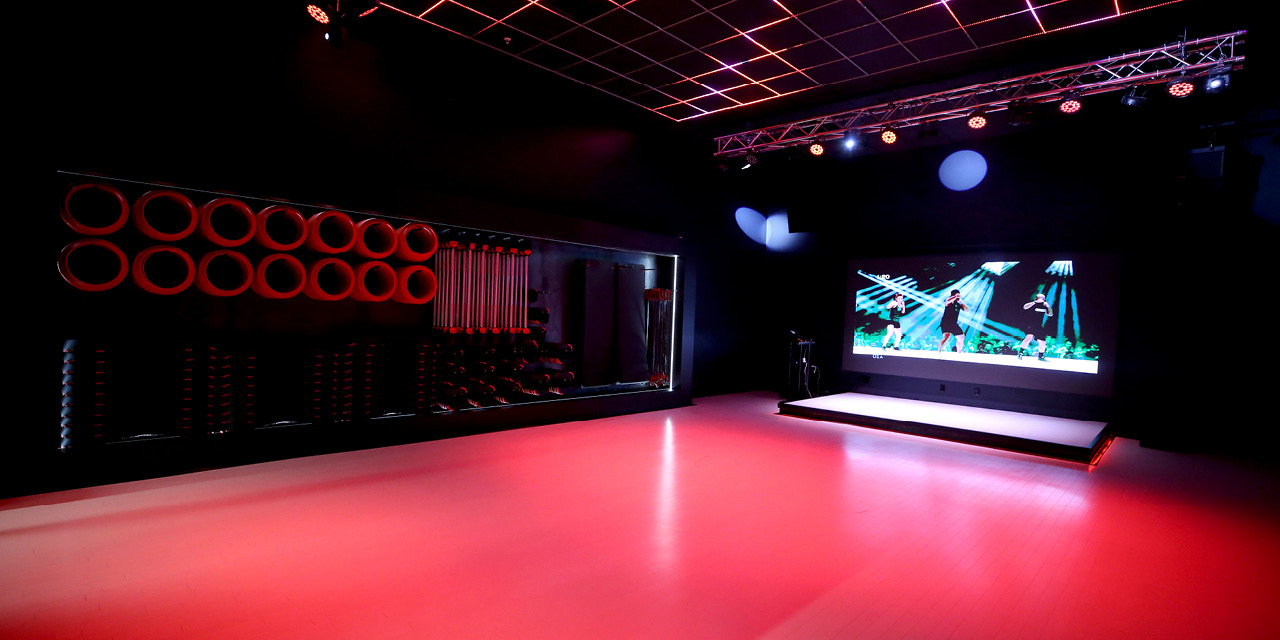
How do you develop your programmes?
Both of us have a strong Les Mills background – Carrie in club management, Amy as the brand’s national training manager – so it won’t be a surprise to know that many of our programmes are Les Mills.
It’s currently all Les Mills programming in URBAN RITUAL, and in CHAIN with TRIP, SPRINT and RPM. But while FREESOL has Les Mills BodyFlow and Barre, we also offer meditation, pilates, tai chi and yoga. And HUSTLE programmes are all created by us, with a new workout made fresh every day. Amy is a certified strength and conditioning specialist and an incredible programmer – we’ll no doubt do more bespoke classes in the future.
What about your virtual classes?
At Styles, virtual is like going to the fitness movies: we create immersive environments that drive member engagement. We often have eight to 10 people in our virtual CHAIN classes, just as an example.
That’s great, because it helps spread the load away from peak times, keeps satisfaction levels high whenever people want to work out, and helps people build group exercise confidence.
Interestingly, the shift away from traditional peak times has become even more pronounced since we re-opened from lockdown. Virtual has been a godsend in this respect: it’s allowed us to cater cost-effectively for our members throughout the day. Members go into the app, see what’s coming next, rock up and they’re guaranteed a world-class experience.
HUSTLE is the one studio where we don’t offer virtual classes, because the space also acts as an extension of the gym floor: people can train in there on their own when there are no classes.
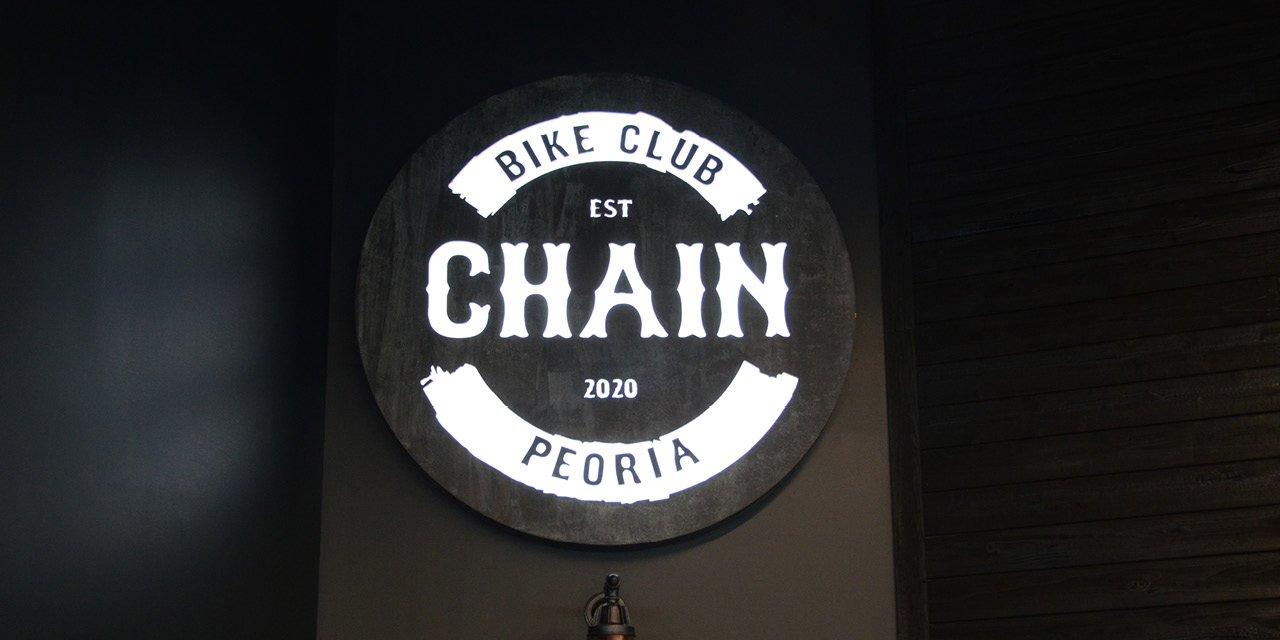
Tell us more about CHAIN.
CHAIN is a fantastic environment and people are going crazy for the immersive experience – there really is nothing else like it in town. Even those who have never cycled before are now regulars.
Many operators worry about the cost of a big screen like we have in CHAIN, but there’s so much you can do with it – you aren’t just putting it in for one class. Our TRIP virtual classes are incredibly popular, but in our live RPM classes, for example, we’ll still use the screen to project high-energy content. You have to create an experiential space.
And it’s worth the investment, because cycling is a modality that’s never going to die. As a non-impact form of exercise, it’s good for all ages. When you also make it an immersive experience, which reduces the perceived exertion while still giving you a great workout… Well, people love it.
We focus on fitness cycling classes at Styles; we don’t have any ‘party on a bike’ classes. We are, however, looking to introduce Stages Flight soon, which will add a more competitive, performance-focused option to the timetable.
What proportion of your members take part in group exercise?
A full 90 per cent of our members have done a class with us at some point, but then our whole model has been built around this.
We’ve flipped the usual model, so our studios are the centrepiece and the gym space secondary
We still wanted to have a gym floor – it’s what people know and somehow it makes the model work, even though it isn’t used as much as the classes. But we’ve certainly flipped the usual model, so our studios are the centrepiece and the gym space secondary.
You say you’ve made membership affordable?
We have an “all under one roof for one price” membership which starts at US$75 a month for a 12-month membership, US$85 a month for six months and US$95 for monthly. That’s premium for our area.
We put prices up slightly after COVID, but we’re still focused on offering great value. We need to be profitable, of course, but profitable with acceptable pricing and good capacity management. We did some interesting research in New Zealand, exploring the ratio between floor space and member capacity, and we’re confident we can get to 2,800–3,000 members and still have everyone feeling good about being here.
Membership includes use of the gym floor and all classes. Nutritional programmes, wellbeing coaching and Dexa cost extra – and are available to non-members too – but we see all of this as invaluable to empowering people on their journey. There’s so much misinformation out there; we want to give people some simple principles they can apply.
Personal training is also available, but we’ve deliberately started small. That said, it’s really taking off since we re-opened.
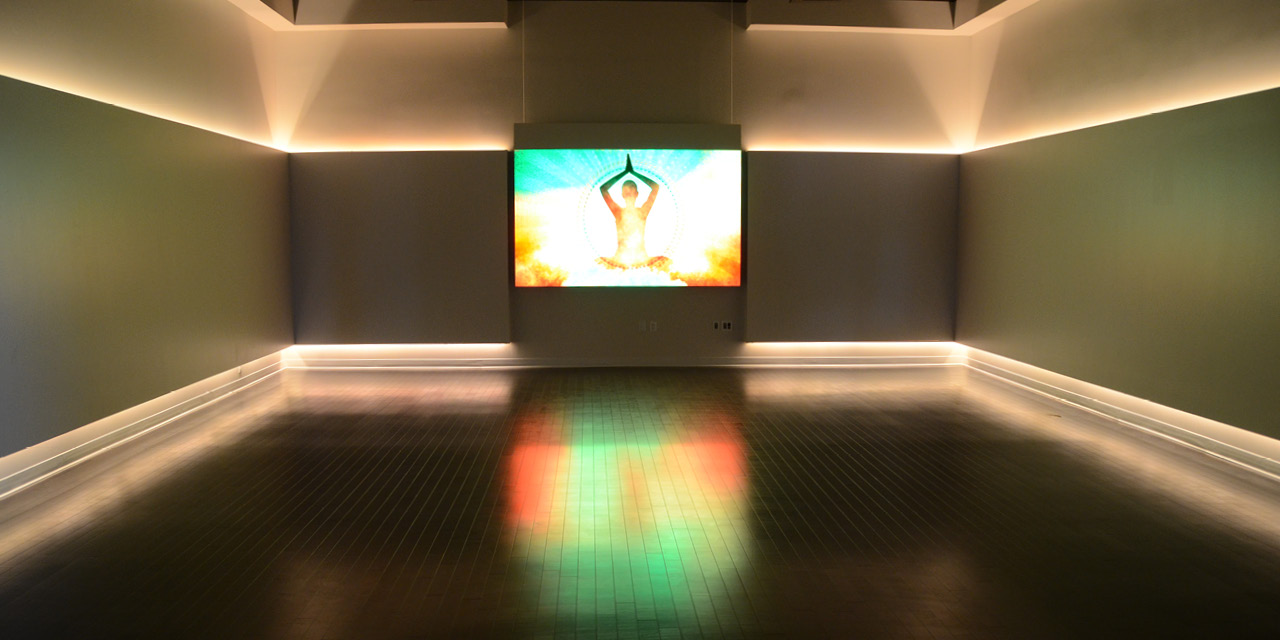
What is your training philosophy?
Our approach is holistic, embracing stress management, nutrition programmes, Dexa scans. Our in-house experts don’t just look at weight loss either, but at things like inflammation, acidity, gut health, adrenal fatigue, detox – underlying factors that, if properly addressed, will bring results.
It’s also why we’ve created a multi-modality model. Because you can’t HUSTLE every day. You need recovery in your routine too.
What is the culture at Styles Studios Fitness?
We aim to be open and empowering, with one of our key straplines being #AllStylesWelcome. It’s about breaking down shame, barriers, doubts. Everyone is welcome.
We’ve done away with bright lights and mirrors. In their place, we have immersive experiences that everyone can get lost in – and we’ve found that men in particular have responded very positively to this. Our membership base is 55/45 female/male and across all our studios, 25–30 per cent of class attendees are male; it’s higher still in CHAIN and HUSTLE classes. Many have never done group exercise before, but they tell us they’re now addicted.
And there’s so much to choose from. It’s summed up in another of our main straplines: #NeverBeBoredAgain.
How are you building a sense of community around Styles Studios Fitness?
Our open approach is a big part of this. We’ve had a lot of people tell us they recognised fellow members from other gyms, but that Styles is the first time they’ve actually spoken to them.
We also let kids over the age of 12 (and up to 21) come and train with their parents, switching their contracts on and off to suit. All generations are loving it and it’s boomed since re-opening, with parents wanting to get their kids moving again.
We have what we like to call a “secret sauce” for our staff culture too. We recruited specifically for the Peoria community we’re here to serve, and we created an internal bible: The Little Book of Styles. It tells our story, our values, who we are, why we’re here and how to live that daily. And we celebrate successes as opposed to dwelling on mistakes: it’s about releasing serotonin and dopamine in our staff, not cortisol.
If you can do well in a B-rated, hard market like this, you stand a chance of scaling your model
And then, of course, is the fact that Styles is our family name – or it will be once Carrie gets round to changing her surname! There’s a very personal, close-knit, family feel to the place.
It all comes together to create a fun, safe environment where people don’t think “I have to go” but rather “Great, I get to go to Styles today!”
One other nice thing: everyone has a Styles wristband, which uses the same technology as Disney’s FastPass. It gives access to the club, operates the lockers, allows you to make cashless purchases – and then outside the club, there’s a community of local businesses who will offer a discount to anyone who shows them their Styles wristband.
LA and NYC dominate the boutique scene. So why Peoria?
This decision was about family. We have a son and we wanted him to grow up close to his grandparents – Carrie’s parents. It has also meant we’ve been able to lean on the support of family as we get this project off the ground.
But interestingly, there’s a saying around here: “If it plays in Peoria, it will play anywhere.” If you can do well in a B-rated, hard market like this, you stand a chance of having a model that’s scalable.
And it has worked well: we opened in January and had got to 500 members after eight weeks. Then COVID lockdown hit and we were closed for eight weeks – a period during which we could probably have grown by another 400–500 members, hitting operational break-even. So, COVID certainly cut the pace of our growth. However, we worked hard to keep the members we had and have since grown to 600 members, with weekly attendance at 90 per cent of pre-COVID [data correct as at 4 August 2020].
Given low levels of local competition and the size of the potential market, we’re confident that – even though fear of COVID is probably cutting our receptive audience in half at the moment – we will still be able to achieve the 2,800–3,000 members we were always aiming for.
Will you open more Styles locations?
We only opened this first site at the beginning of the year, so we’re still finessing the offering. Developing our model was a three-year project and we’re still very much on the learning curve.
Equally, we didn’t set out just to grow a chain. We wanted to get people healthier and fitter, happier and more confident.
However, we are getting some investor interest, so if we turn out to be the next cool thing, we’re fully open to the conversation, whether that’s opening more sites ourselves or franchising the concept.
If we build more Styles sites, we’ll probably look for 16,000–18,000sq ft in total so all the studios can be bigger. Proportionally the other studios will still be bigger than URBAN RITUAL though; it’s in HUSTLE, CHAIN and FREESOL where we run our trademark, signature programmes and where we place our main focus.
Equally, it would be easy to see our HUSTLE brand working well as a standalone boutique.
Whatever we do, though, it will be the smaller cities we focus on – the places that haven’t seen anything like the spaces we create, and where we can therefore make the biggest impact. And we will always actively look for dense pockets of Les Mills instructors. They’ve had the best instructor training in the world, so we know all we need to do is give them the right tools to create a world-class experience.
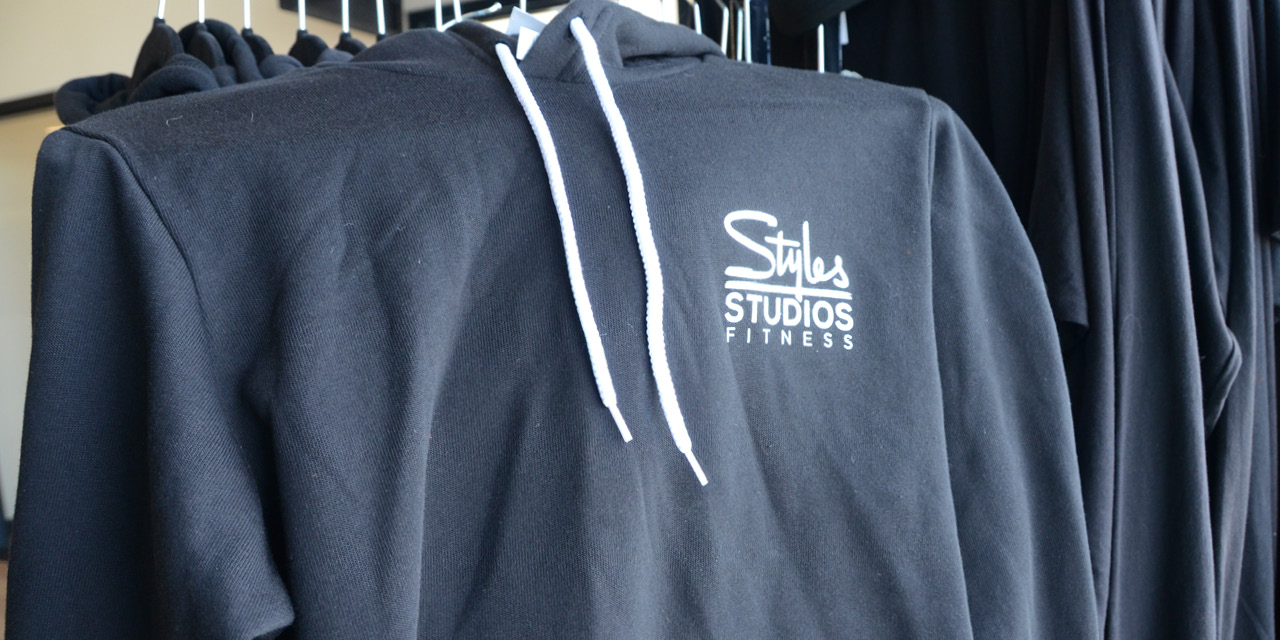
Tackling COVID head-on
“We came out of the blocks quickly in our COVID response,” says Styles Studios Fitness co-founder Carrie Kepple. “Amy and I had been through a crisis before – at the Les Mills Christchurch club that was hit by an earthquake in 2011 – and I think it was this that made us accept what was happening quickly rather than spending weeks fretting over it. We just said: ‘Well, this is happening. Let’s react now. Let’s control what we can control.’
“We closed with 500 members and spent lockdown focused on looking after this core group. We prioritised people over payment and focused on community – on being a club and supporting our members’ wellbeing. The support and engagement that flowed as a result has been incredible: we retained 98 per cent of our members, with many of them continuing to pay through lockdown even though we told them we didn’t expect it, and we’ve come through this with higher levels of loyalty than ever.”
Kepple continues: “We launched free online fitness for all our members, including those on frozen memberships, initially through a closed Facebook group and then through our member-only app. We live streamed a couple of classes a day – including meditation, self-care, mental fitness – and members were tuning in religiously.
“We’re continuing to offer online now, including it in all our memberships; our studios are set up with cameras, so it doesn’t cost us any more to live stream a class that’s running anyway. It’s great for the times when members can’t make it to the club, adds real perceived value and makes it far more likely that people will stay with us for a long time.
“We’re also selling online-only memberships, currently for US$25 a month – we’ll work out if that’s the right price over the coming months. But really, for non-members, our big focus is now our HUSTLE@home app – www.stylesstudiosfitness.com/hustleathomeapp – which again we launched during lockdown. Anyone in the world can buy this app and it gives you access to all sorts of features on top of our live and on-demand classes. It costs just US$14.99 a month, or US$59 for a whole year.
“Other new areas of business launched in the last couple of months are our physician- and FDA-approved high-end supplement line, Designs for Health, and a made-to-order clothing line.
“We’re also the first US facility to partner with FitTrace, creating FitTrace for Athletes; when student athletes have a Dexa scan with us, their body composition is mapped against that of a pro athlete playing in the same position in their game, and they get a personalised consultation to identify what they can improve. We’re partnering with Bradley University to put all their athletes through this programme.”
The pain-reducing power of VR
Group exercise. The entertaining, engaging, dare we say it even fun part of a gym’s offering. The community creator. The loyalty builder and retention booster. True before COVID; still true even in these strange days of social distancing.
Yet even without social distancing and its resulting capacity issues, group exercise throws up obstacles to participation, not least the intimidation factor of being the newbie among a group of regulars. And that intimidation factor is arguably never more evident than in group cycling – so often perceived as a hardcore workout led by gung-ho instructors exhorting regulars to crank it up in a ‘who can work the hardest’ battle.
“Our cycling classes aren’t like that,” you say. Quite possibly not, but this is all about perception. And if we’re honest with ourselves, we have to acknowledge that this perception hasn’t come from nowhere. For many years, that’s what so many of these classes were like. Instructors would see it as a badge of honour if participants wobbled out of the studio on jelly legs at the end of the class.
For those exposed to the interactive VR, the pain intensity was 12–13 per cent lower
Perceptions are now shifting, in part thanks to the growth in rhythm cycling – the SoulCycle-esque, ‘party on a bike’ classes which have broadened the appeal of group cycling, making it as much about the mental feelgood as the physical results. Where people don’t feel beasted through every pedal stroke.
But there is another tool at your disposal: one that’s reportedly drawing new audiences in to give cycling a try, and which research shows then seals the deal by making the whole experience more enjoyable, reducing perceived effort levels – even when it is a tough workout.
That tool is virtual reality.
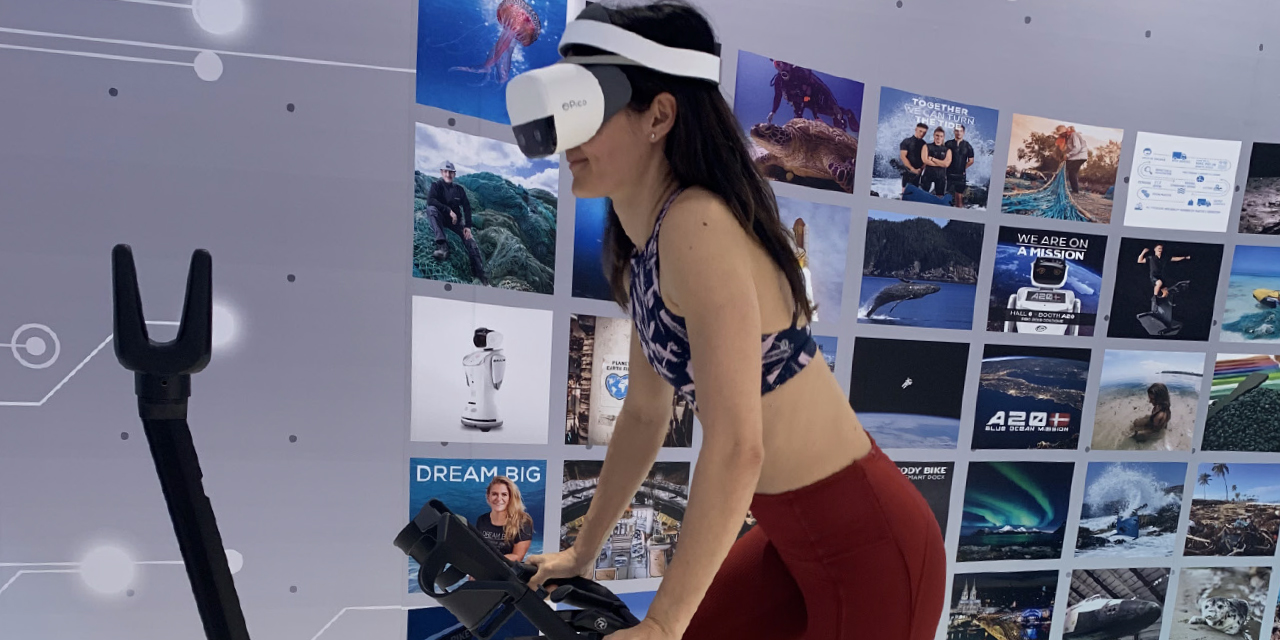
Interactive VR versus muscle pain
High-intensity cycling is less painful when combined with virtual reality, according to a study published last year by University of Georgia researchers.
Past studies have shown that exposure to virtual reality (VR) can help medical patients better manage their pain. This latest study wanted to explore the topic further, investigating whether the use of virtual reality during high-intensity cycling could reduce pain from exercise.
The study tested 94 healthy adults, specifically selecting those who didn’t have a high likelihood of motion sickness – one of the potential drawbacks of using a VR headset.
Wearing their VR headsets, all participants completed three 30-second cycling sprints, each followed by four minutes of recovery. Half of the participants were shown a dynamic virtual cityscape: a changing VR environment which made them feel as though they were actively cycling through it. The other half – the control group – viewed a non-interactive, static picture of the same cityscape and were asked to mentally imagine cycling through the city while they completed the same cycling workout.
The study found that, among those who were exposed to the interactive VR experience, the perceived pain intensity in their quadriceps was 12–13 per cent lower during the second and third sprints compared to participants in the non-interactive group.
Meanwhile, cycling performance was the same across the board; pain relief was not a side-effect of reduced cycling performance among those engaged by the interactive VR experience.
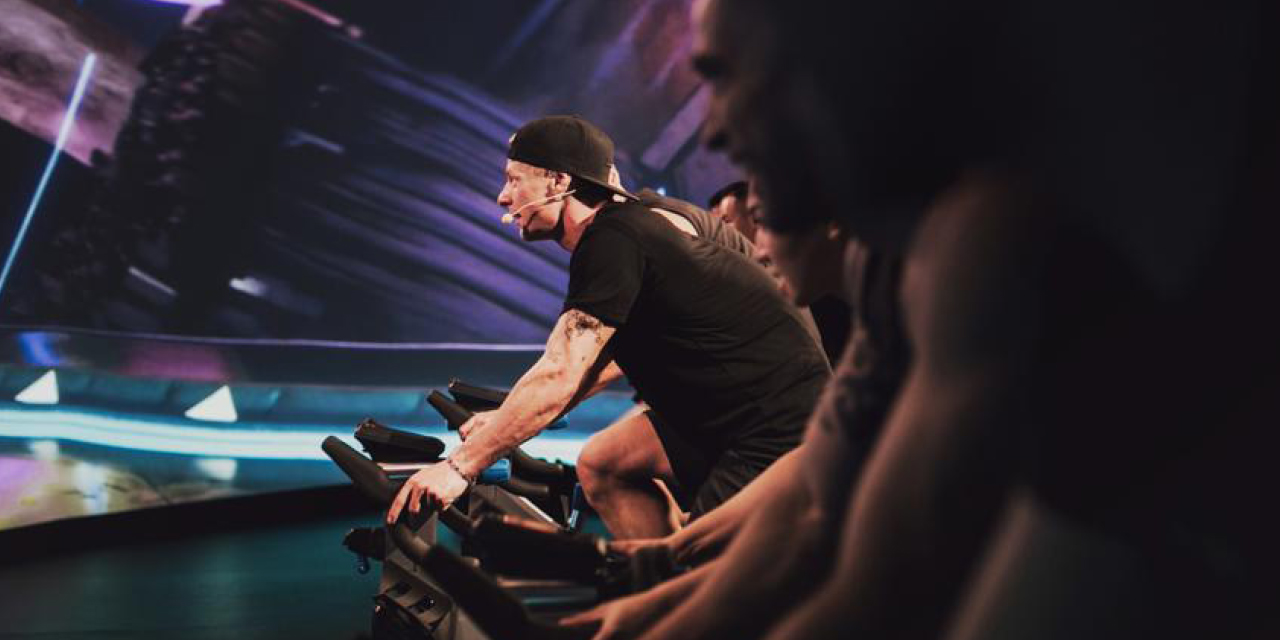
Immersive experience versus RPE
Research conducted in 2017 on behalf of Les Mills International – exploring the impact of its immersive cycling class THE TRIP – reached similar conclusions, particularly among novice cyclists.
Rate of perceived exertion and fatigue were a lot less when doing an immersive class
Carried out by associate professor Jinger Gottschall and her Penn State University research team, and published in Medicine & Science in Sports & Exercise – the journal of the American College of Sports Medicine (ACSM) – the study compared THE TRIP’s immersive class with an audio-only class, both among experienced and novice indoor cyclists.
Heart rate data (percentage of time spent in the 80–100 per cent maximum heart rate zone) was tracked during the class to establish exercise intensity, while a survey conducted immediately after each class looked at rate of perceived exertion, satisfaction and enjoyment.
Among experienced cyclists, the impact wasn’t too dramatic. However, for novices, the immersive audiovisual experience was enough to distract them from the pain of the workout – this in spite of the fact that only 19 per cent of a TRIP class is spent in either a light- or very light-intensity heart rate zone. Moderate intensity work comprises 32 per cent of the class, with 26 per cent being high intensity and 23 per cent maximum intensity.
“The results showed the novice group’s rate of perceived exertion (RPE) – how hard they thought they had worked out – and perception of fatigue were a lot less when doing an immersive class in comparison with the audio-only class, when in fact the intensity was exactly the same,” says Dr Gottschall.
Anecdotal feedback reinforces these findings. One study participant summed it up perfectly: “I got so lost in the visuals that I had no idea how hard I was working until I saw the pool of sweat below my bike when the lights were turn on – super cool!”



